SAT Test Prep
CHAPTER 16
PRACTICE TESTS WITH DETAILED ANSWER KEYS

PRACTICE TEST 1
ANSWER SHEET

Directions for Test
• Remove these answer sheets from the book and use them to record your answers to this test.
• This test will require 3 hours and 20 minutes to complete. Take this test in one sitting.
• The time allotment for each section is written clearly at the beginning of each section. This test contains six 25-minute sections, two 20-minute sections, and one 10-minute section.
• This test is 25 minutes shorter than the actual SAT, which will include a 25-minute “experimental” section that does not count toward your score. That section has been omitted from this test.
• You may take one short break during the test, of no more than 10 minutes in length.
• You may only work on one section at any given time.
• You must stop ALL work on a section when time is called.
• If you finish a section before the time has elapsed, check your work on that section. You may NOT work on any other section.
• Do not waste time on questions that seem too difficult for you.
• Use the test book for scratchwork, but you will receive credit only for answers that are marked on the answer sheets.
• You will receive one point for every correct answer.
• You will receive no points for an omitted question.
• For each wrong answer on any multiple-choice question, your score will be reduced by ¼ point.
• For each wrong answer on any “numerical grid-in” question, you will receive no deduction.
When you take the real SAT, you will be asked to fill in your personal information in grids as shown below.

Start with number 1 for each new section. If a section has fewer questions than answer spaces, leave the extra answer spaces blank. Be sure to erase any errors or stray marks completely.
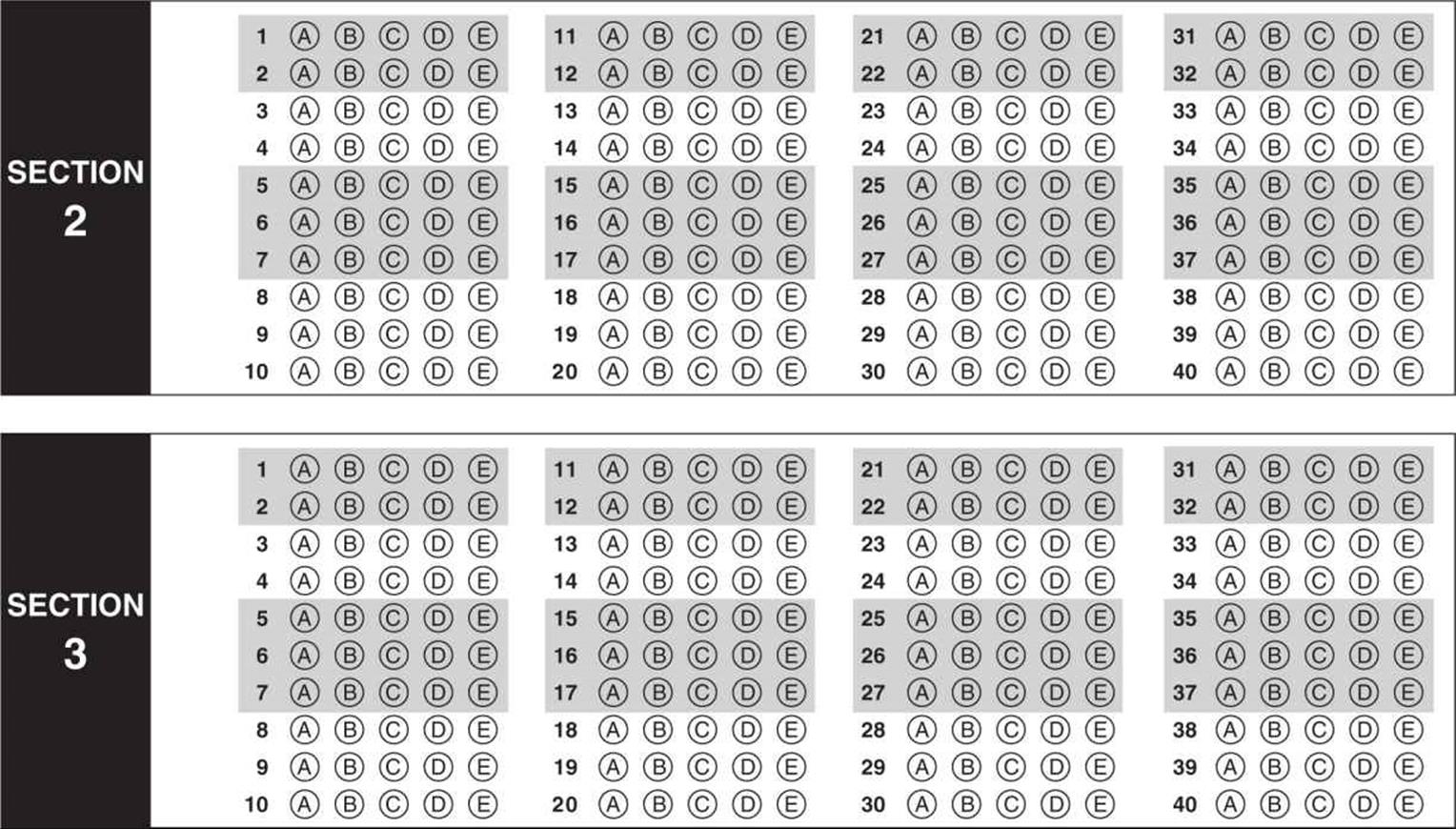
CAUTION
Use the answer spaces in the grids below for Section 2 or Section 3 only if you are told to do so in your test book.
Student-Produced Responses
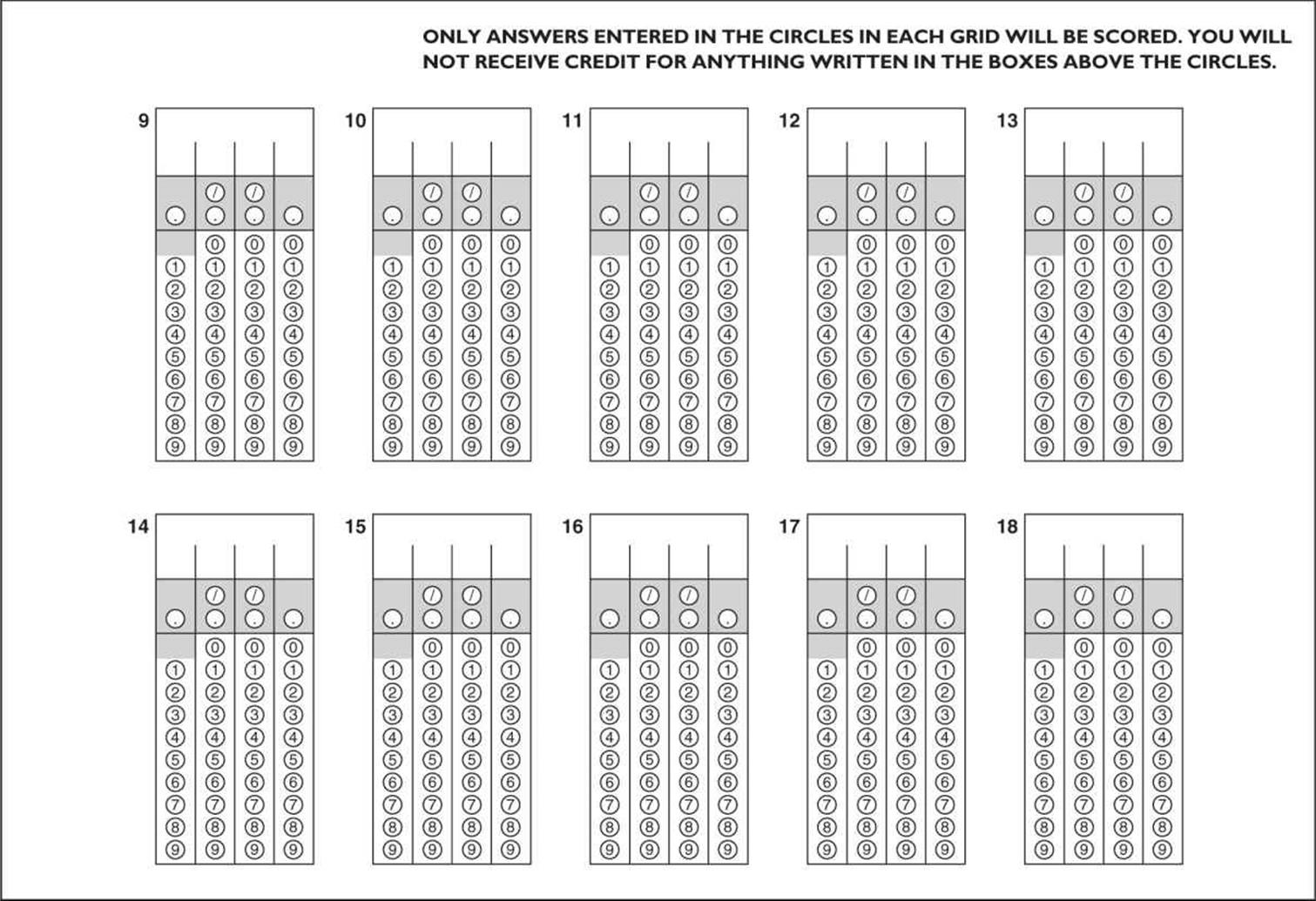
Start with number 1 for each new section. If a section has fewer questions than answer spaces, leave the extra answer spaces blank. Be sure to erase any errors or stray marks completely.
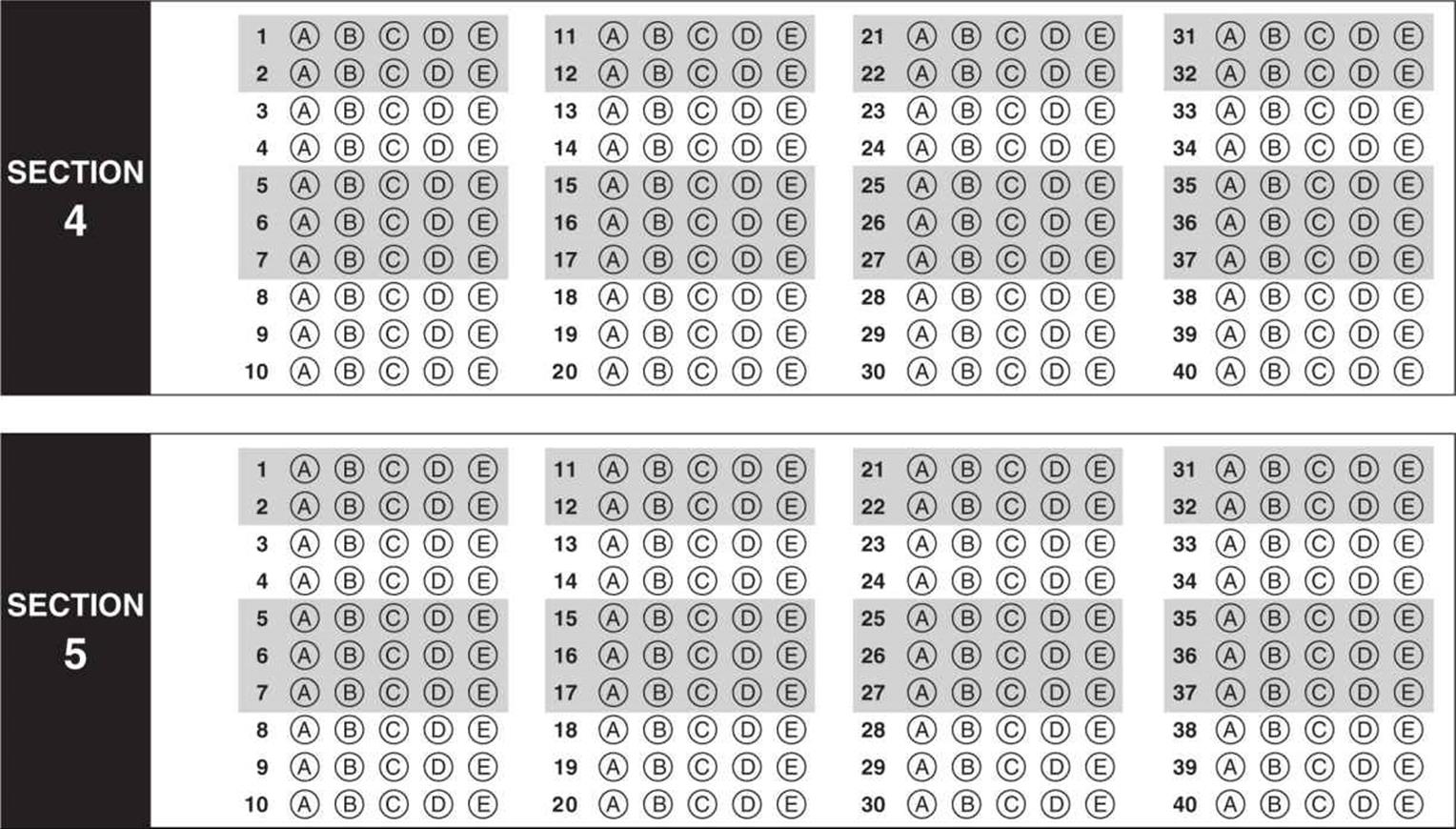
CAUTION
Use the answer spaces in the grids below for Section 4 or Section 5 only if you are told to do so in your test book.
Student-Produced Responses
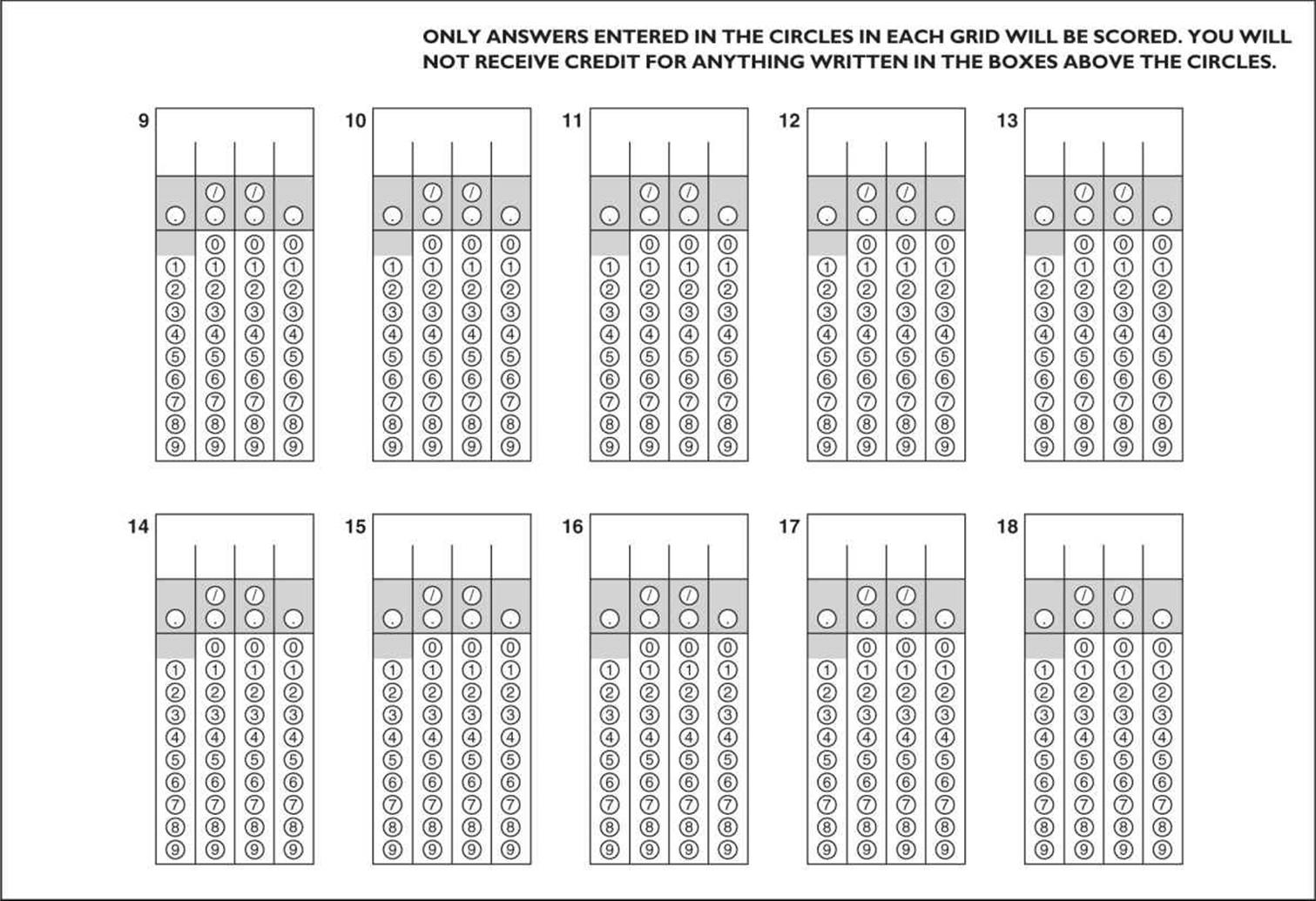
Start with number 1 for each new section. If a section has fewer questions than answer spaces, leave the extra answer spaces blank. Be sure to erase any errors or stray marks completely.
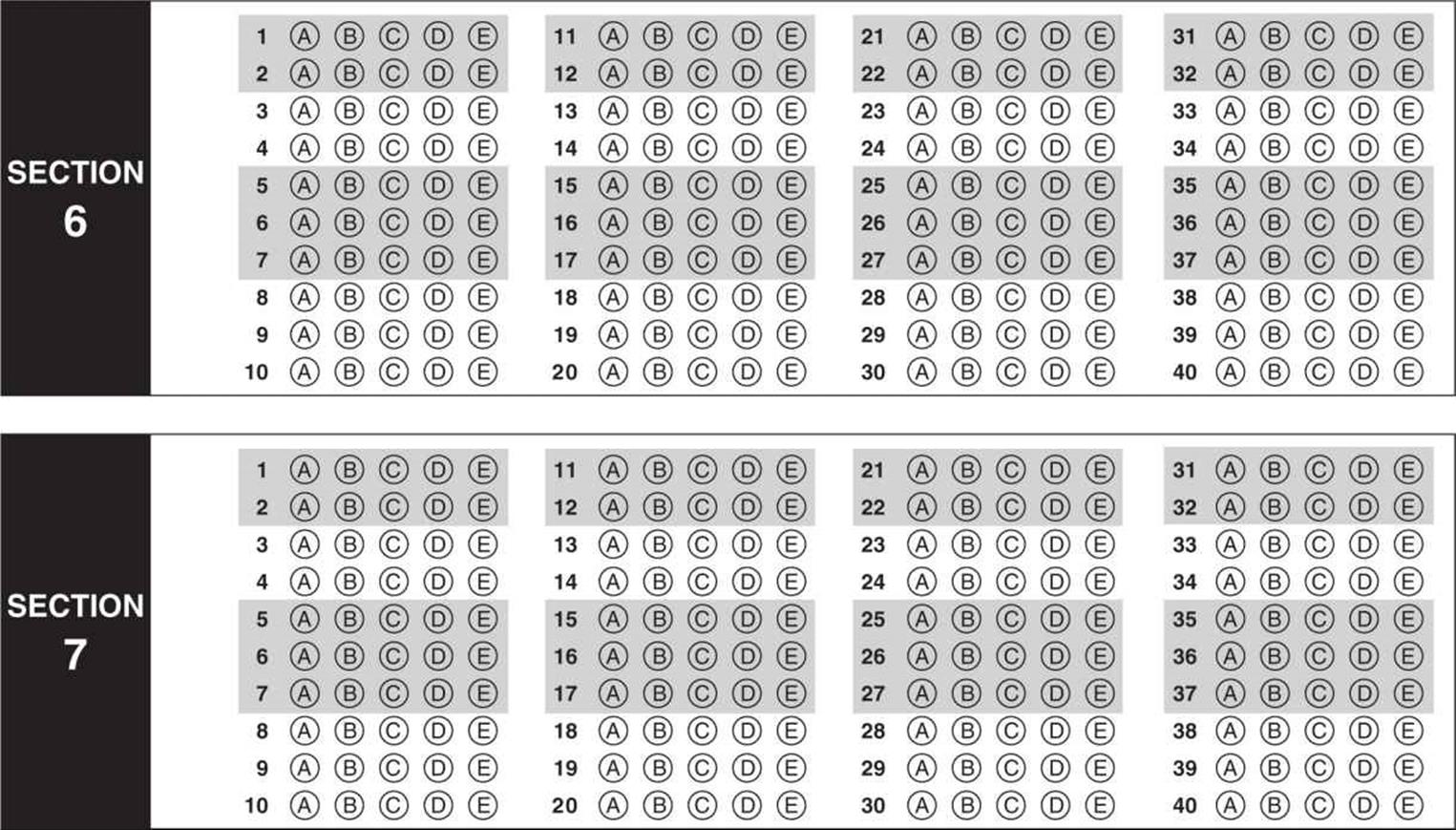
CAUTION
Use the answer spaces in the grids below for Section 6 or Section 7 only if you are told to do so in your test book.
Student-Produced Responses
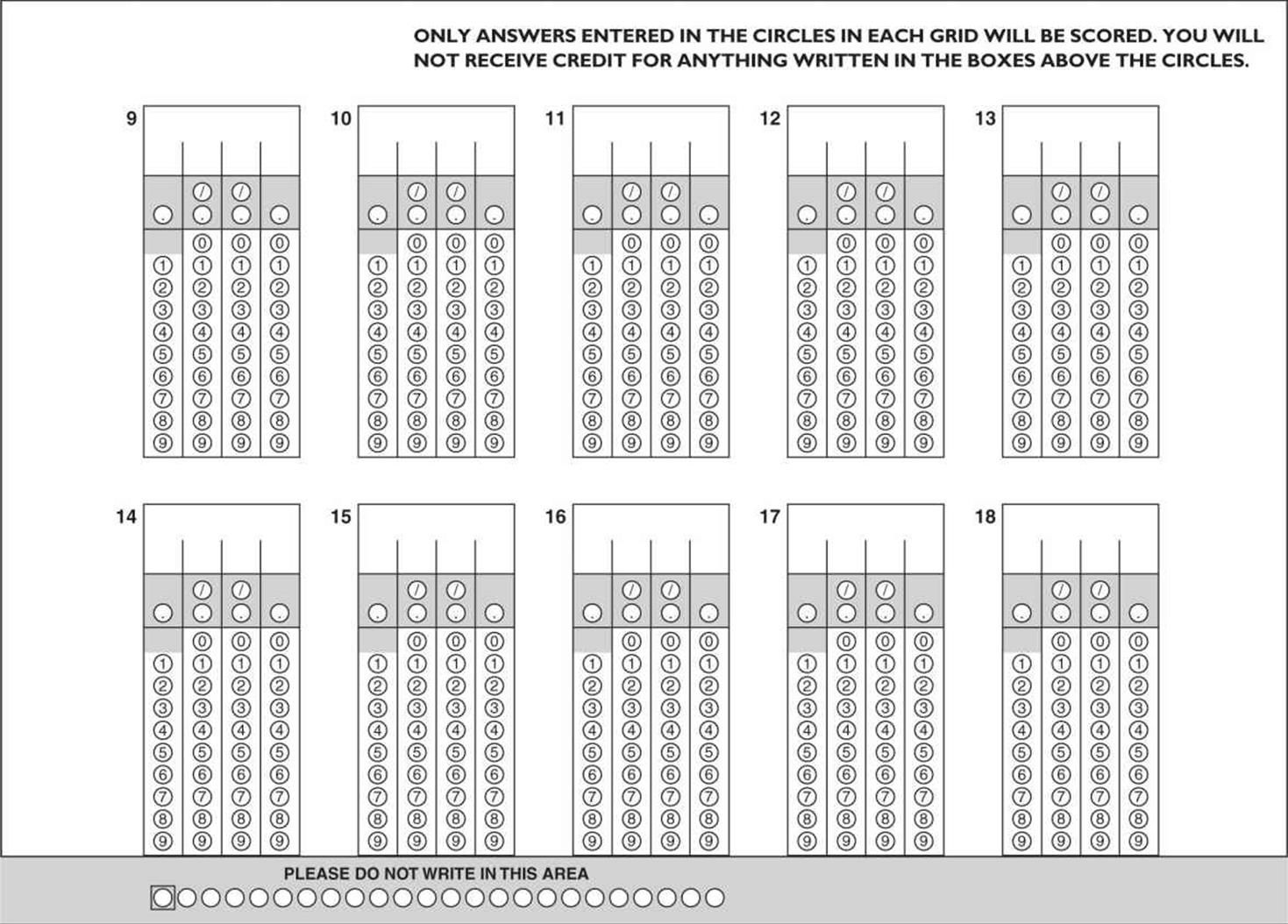
Start with number 1 for each new section. If a section has fewer questions than answer spaces, leave the extra answer spaces blank. Be sure to erase any errors or stray marks completely.

ESSAY
Time—25 minutes
Write your essay on separate sheets of standard lined paper.
The essay gives you an opportunity to show how effectively you can develop and express ideas. You should therefore take care to develop your point of view, present your ideas logically and clearly, and use language precisely.
Your essay must be written on the lines provided on your answer sheet—you will receive no other paper on which to write. You will have enough space if you write on every line, avoid wide margins, and keep your handwriting to a reasonable size. Remember that people who are not familiar with your handwriting will read what you write. Try to write or print so that what you are writing is legible to those readers.
Important reminders:
• A pencil is required for the essay. An essay written in ink will receive a score of zero.
• Do not write your essay in your test book. You will receive credit only for what you write on your answer sheet.
• An off-topic essay will receive a score of zero.
You have twenty-five minutes to write an essay on the topic assigned below.
Think carefully about the issue presented in the following excerpt and the assignment below.
An entertainment-driven culture runs the risk of encouraging passivity among its citizens. If they can experience something vicariously through a movie, television show, or video game, why should they get involved with the activity itself? It”s safer, after all, to watch someone scale a mountain than to do it yourself. The effect of this passivity, of course, is an apathetic frame of mind. We cease to care deeply about so many things because they are experienced, at best, second-hand.
Assignment: Is apathy a problem in today”s society? Write an essay in which you answer this question and discuss your point of view on this issue. Support your position logically with examples from literature, the arts, history, politics, science and technology, current events, or your experience or observation.
If you finish before time is called, you may check your work on this section only.
Do not turn to any other section in the test.
SECTION 2
Time—25 minutes
20 questions
Turn to Section 2 of your answer sheet to answer the questions in this section.
Directions: For this section, solve each problem and decide which is the best of the choices given. Fill in the corresponding circle on the answer sheet. You may use any available space for scratchwork.
Notes
1. The use of a calculator is permitted.
2. All numbers used are real numbers.
3. Figures that accompany problems in this test are intended to provide information useful in solving the problems. They are drawn as accurately as possible EXCEPT when it is stated in a specific problem that the figure is not drawn to scale. All figures lie in a plane unless otherwise indicated.
4. Unless otherwise specified, the domain of any function f is assumed to be the set of all real numbers x for which f (x) is a real number.
Reference Information

The number of degrees of arc in a circle is 360.
The sum of the measures in degrees of the angles of a triangle is 180.
1. If x = 3 and ![]() , then y =
, then y =
(A) 1.5
(B) 2
(C) 3
(D) 4
(E) 6
2. A store sells a package of 6 batteries for $4 and a package of 24 of the same batteries for $12. If you need to buy 48 of these batteries, how much money will you save by buying them in packages of 24 rather than packages of 6?
(A) $4
(B) $8
(C) $12
(D) $16
(E) $20
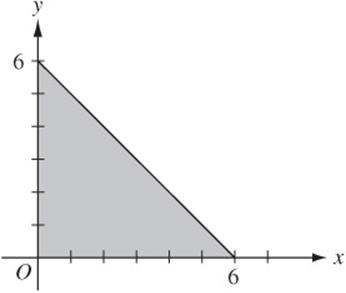
3. Which of the following points does NOT lie in the shaded region above?
(A) (1, 1)
(B) (1, 4)
(C) (2, 3)
(D) (4, 1)
(E) (5, 5)
4. If ![]() of 2x is 5, what is
of 2x is 5, what is ![]() of 4x?
of 4x?
(A) 5
(B) 10
(C) 15
(D) 20
(E) 25
5. If n is a positive integer that is divisible by 12 and 16, then n must also be divisible by
(A) 28
(B) 32
(C) 48
(D) 96
(E) 192
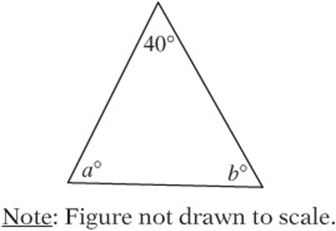
6. In the figure above, if ![]() , then a =
, then a =
(A) 60
(B) 65
(C) 70
(D) 75
(E) 80
7. If n is an integer, which of the following must be an even integer?
![]()
![]()
![]()
(D) n2
![]()
8. Mike sold a total of 48 sodas at a snack stand. The stand sells only cola and root beer. If he sold twice as many colas as root beers, how many root beers did he sell?
(A) 32
(B) 24
(C) 18
(D) 16
(E) 8
9. If m and n are both squares of integers, which of the following is NOT necessarily the square of an integer?
(A) 9m
(B) mn
(C) m2
(D) 9mn
(E) 9m-9n
10. If ![]() ,
, ![]() , and
, and ![]() , then
, then ![]()
(A) –5
(B) –3
(C) 3
(D) 5
(E) 23
11. If the average (arithmetic mean) of a, b, 4, and 10 is 8, what is the value of a + b?
(A) 4
(B) 6
(C) 9
(D) 15
(E) 18
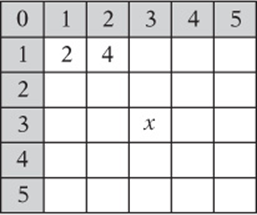
12. With the exception of the shaded squares, every square in the figure above contains the sum of the number in the square directly above it and the number in the square directly to its left. For example, the number 4 in the unshaded square above is the sum of the 2 in the square above it and the 2 in the square directly to its left. What is the value of x?
(A) 6
(B) 7
(C) 8
(D) 15
(E) 30
13. If a, b, and c are positive even integers such that ![]() and
and ![]() , then the greatest possible value of c is
, then the greatest possible value of c is
(A) 36
(B) 40
(C) 42
(D) 54
(E) 57
14. The population of Bumpton increased by 10% from 1980 to 1990 and decreased by 10% from 1990 to 2000. What is the net percent change in the population of Bumpton from 1980 to 2000?
(A) –9%
(B) –1%
(C) +0%
(D) +1%
(E) +9%
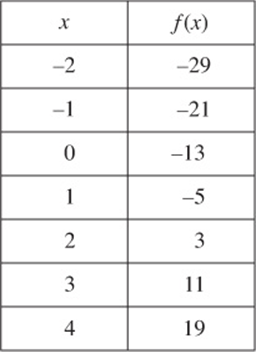
15. Several values of the function f are shown above. The function g is defined by ![]() . What is the value of g (3)?
. What is the value of g (3)?
(A) –21
(B) –13
(C) 3
(D) 11
(E) 21
16. If ![]() and
and ![]() , then
, then ![]()
(A) 2y
![]()
(C) 4y
(D) 16y
(E) 24y
17. If ![]() , which of the following must be true?
, which of the following must be true?
![]()
![]()
![]()
(A) I only
(B) II only
(C) I and II only
(D) I and III only
(E) I, II, and III

18. Which of the following represents the distance from the midpoint of ![]() to the midpoint of
to the midpoint of ![]() on the number line above?
on the number line above?
![]()
![]()
![]()
![]()
(E) 4x
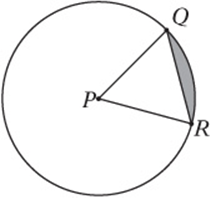
19. P is the center of the circle above and ![]() . If ΔPQR has an area of,
. If ΔPQR has an area of, ![]() what is the area of the shaded region?
what is the area of the shaded region?
![]()
![]()
![]()
![]()
![]()
20. In a class of 160 seniors, the ratio of boys to girls is 3 to 5. In the junior class, the ratio of boys to girls is 3 to 2. When the two classes are combined, the ratio of boys to girls is 1 to 1. How many students are in the junior class?
(A) 400
(B) 360
(C) 200
(D) 180
(E) 160

If you finish before time is called, you may check your work on this section only. Do not turn to any other section of the test.
SECTION 3
Time—25 minutes
24 questions
Turn to Section 3 of your answer sheet to answer the questions in this section.
Directions: For each question in this section, select the best answer from among the choices given and fill in the corresponding circle on the answer sheet.
Each sentence below has one or two blanks, each blank indicating that something has been omitted. Beneath the sentence are five words or sets of words labeled A through E. Choose the word or set of words that, when inserted in the sentence, best fits the meaning of the sentence as a whole.
EXAMPLE:
Rather than accepting the theory unquestioningly, Deborah regarded it with-----.
(A) mirth
(B) sadness
(C) responsibility
(D) ignorance
(E) skepticism
![]()
1. Julia feared that her 6-month hiatus from playing the piano would cause her musical skills to -------.
(A) atrophy
(B) align
(C) develop
(D) reconcile
(E) disseminate
2. Senator Harris is widely viewed as a ------- orator; his speeches are full of ------- commentary and domineering opinions.
(A) vindictive . . pedantic
(B) conciliatory . . treacherous
(C) didactic . . moralizing
(D) dogmatic . . meek
(E) simplistic . . prosaic
3. Walter”s ------- was beginning to annoy his coworkers; although they appreciated the thought he gave to his decisions, his inability to make up his mind was growing tiresome.
(A) vacillation
(B) solicitation
(C) rejuvenation
(D) admonishment
(E) professionalism
4. To succeed as a writer, one needs a great deal of -------; successful writers are ------- even in the face of countless rejections.
(A) affluence . . haughty
(B) pertinacity . . apologetic
(C) intimidation . . resilient
(D) tenacity . . relentless
(E) stoutness . . craven
5. Although direct, forceful stances usually appeal to voters on the campaign trail, candidates usually resort to ------- during debates to avoid alienating any potential supporters.
(A) pontification
(B) circumlocution
(C) logic
(D) exaggeration
(E) brevity
6. Counselors in the prison rehabilitation program must have faith in the ------- of those who have committed felonies, yet be wary of -------; they must believe that criminals can change, but know that they can often return to their old habits.
(A) mutability . . astuteness
(B) variability . . consistency
(C) coarseness . . responsibility
(D) persuasion . . transcendence
(E) malleability . . relapse
7. Marullus” reference to “chimney-tops” during his monologue in Julius Caesar is considered by some historians -------, since such things are unlikely to have existed in Rome in the first century BC.
(A) a miscalculation
(B) an anachronism
(C) an idiom
(D) an interlocutor
(E) a mirage
8. The letter “h” at the end of Pittsburgh is ------- of American sentiments soon after World War I; it was added as part of a movement during that time to make the names of American cities sound less German.
(A) an inference
(B) an analogy
(C) a vestige
(D) an anomaly
(E) a quandary
The passages below are followed by questions based on their content. Answer the questions on the basis of what is stated or implied in the passage and in any introductory material that may be provided.
Questions 9 and 10 are based on the following passage.
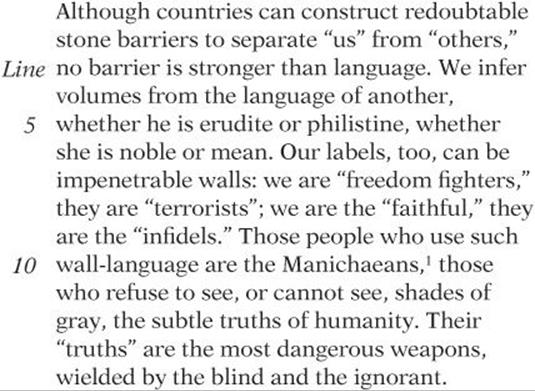
9. In this paragraph, language is characterized primarily as
(A) biased
(B) enlightening
(C) difficult to understand
(D) unifying
(E) changeable
10. In line 4, the word “volumes” most nearly means
(A) spaces
(B) editions
(C) measurements
(D) an abundance
(E) capacities
Questions 11 and 12 are based on the following passage.
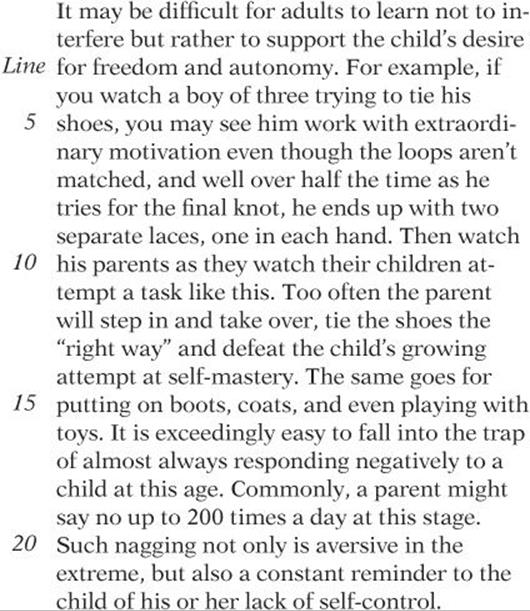
11. The passage suggests that helping a boy to tie his shoes the “right way” (line 13) can be
(A) necessary to his self-esteem
(B) important to his personal hygiene
(C) appropriate only if the boy has the necessary fine motor skills
(D) essential to teaching him patience
(E) harmful to his autonomous development
12. The passage indicates that negative responses to a child can lead to the child”s
(A) rebellion
(B) feeling of helplessness
(C) persistence in the task
(D) mimicking of the negative behavior
(E) anger
Second passage: Educational Psychology: A Developmental Approach, Norman A. Sprinthall et al., McGraw-Hill, 1994, p. 149
Questions 13–18 are based on the following passage.
The following is an essay about T. S. Eliot, an American poet of the early 20th century, and the Modernist movement, of which he was a part.
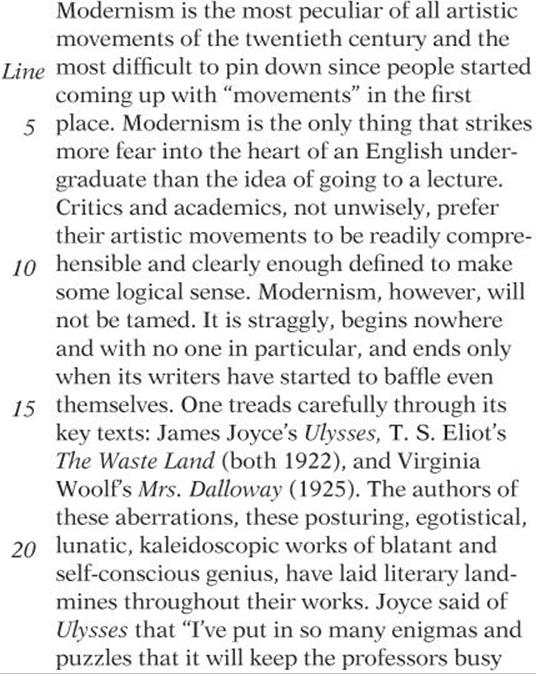

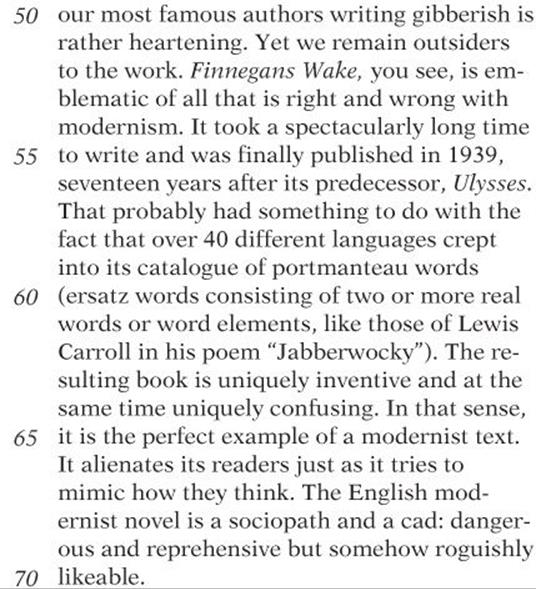
13. In the first paragraph, the author characterizes Modernism as which of the following?
I. self-centered
II. ill-defined
III. politically oriented
(A) I only
(B) II only
(C) I and II only
(D) I and III only
(E) I, II, and III
14. The passage suggests that critics and academics dislike artistic movements that are
(A) enigmatic
(B) comprehensible
(C) wide-ranging
(D) inventive
(E) socially conscious
15. The “landmines” in lines 21–22 are
(A) episodes in novels that refer to violence
(B) criticisms of the works of other novelists
(C) new methods of analyzing literature
(D) literary devices intended to baffle academics
(E) limitations that publishers place on an author”s work
16. The reference to “wave upon wave” (line 34) suggests that, in Modernist fiction, plot is
(A) a powerfully moving element
(B) secondary to other considerations
(C) dominant over diction
(D) characterized by redundancy
(E) dangerous
17. The author”s overall attitude toward Modernism can best be described as
(A) ambivalent
(B) reverential
(C) cynical
(D) indignant
(E) jocular
18. The final sentence of the passage employs each of the following EXCEPT
(A) simile
(B) juxtaposition
(C) personification
(D) contrast
(E) metaphor
Excerpted from T. S. Eliot and the Elitism of Modernism, by David Pinching, on http://www.bibliomania.com
Questions 19–24 are based on the following passage.
The following is an excerpt from a book on genomics, the new science of gathering and using the information encoded in the genes of an organism.
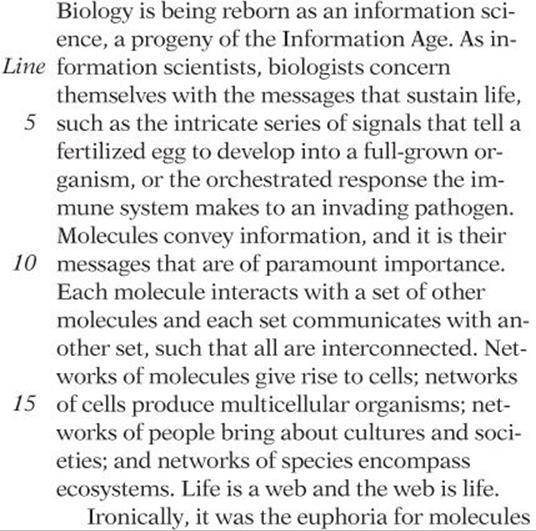
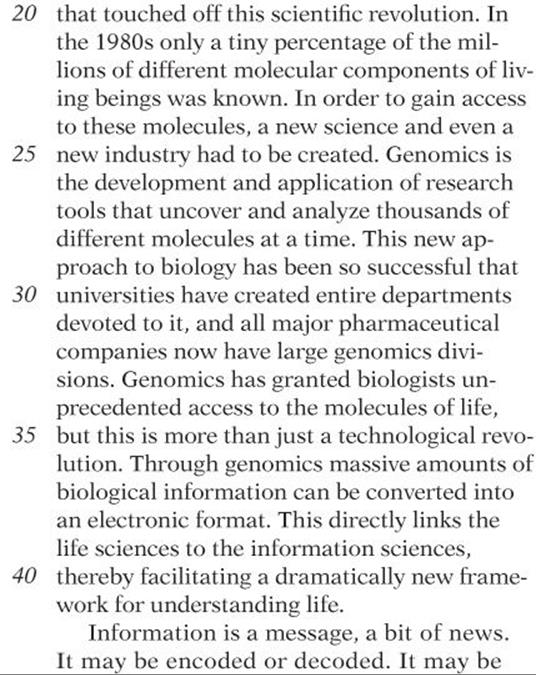
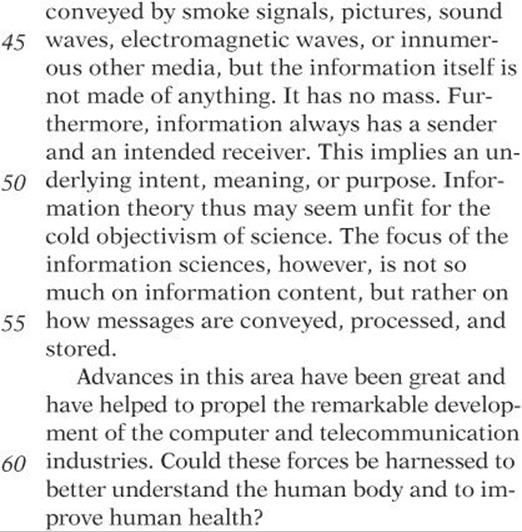
Transducing the Genome, Gary Zweiger, McGraw-Hill, pp. xi–xii
19. The primary purpose of this passage is to
(A) refute a theory
(B) describe the origins of a misconception
(C) analyze different perspectives on a phenomenon
(D) describe a new trend in a field of study
(E) suggest a new method of teaching
20. The passage mentions each of the following as an example of elements interrelating to form a larger whole EXCEPT
(A) molecules forming a cell
(B) organisms forming an ecosystem
(C) pathogens forming the immune system
(D) individuals forming a society
(E) cells forming an organism
21. The passage mentions the “orchestrated response” (line 7) primarily as an example of
(A) the coordinated efforts of scientists
(B) molecules conveying information
(C) the work being done to promote genomics
(D) the similarity between cells and computers
(E) an unrealized potential of the cell
22. According to the passage, the “dramatically new framework” (lines 40–41) is one in which
(A) new university buildings are being built
(B) the immune system attacks a pathogen
(C) networks of molecules give rise to cells
(D) genomics research receives more federal funding
(E) biological data is translated into a new form
23. According to the passage, information theory “may seem unfit for the cold objectivism of science” (line 51–52) because
(A) it is better suited to commercial industry than to academic study
(B) it can be conveyed by sound waves
(C) it suggests that messages may have meaning or purpose
(D) it is not rigorously studied
(E) it analyzes biological information
24. Which of the following best describes the function of the final paragraph in relation to the rest of the passage?
(A) It modifies a theory presented earlier.
(B) It provides a solution to a problem mentioned earlier.
(C) It raises doubts about the value of genomics.
(D) It indicates actual and potential consequences of genomics.
(E) It mentions a viable alternative to genomics.

If you finish before time is called, you may check your work on this section only. Do not turn to any other section of the test.
SECTION 4
Time—25 minutes
35 questions
Turn to Section 4 of your answer sheet to answer the questions in this section.
Directions: For each question in this section, select the best answer from among the choices given and fill in the corresponding circle on the answer sheet.
The following sentences test correctness and effectiveness of expression. Part of each sentence or the entire sentence is underlined; beneath each sentence are five ways of phrasing the underlined material. Choice A repeats the original phrasing; the other four choices are different. Select the choice that completes the sentence most effectively.
In making your selection, follow the requirements of standard written English; that is, pay attention to grammar, choice of words, sentence construction, and punctuation. Your selection should result in the most effective sentence—clear and precise, without awkwardness or ambiguity.
EXAMPLE:
The children couldn”t hardly believe their eyes.
(A) couldn”t hardly believe their eyes
(B) could hardly believe their eyes
(C) would not hardly believe their eyes
(D) couldn”t nearly believe their eyes
(E) couldn”t hardly believe his or her eyes
![]()
1. The controversial themes, which resonate with recent political events, explain why the book is selling at such a feverish pace.
(A) explain why the book is selling at such a feverish pace
(B) explains the feverish pace of the book
(C) explain the reason for the pace of the book”s feverish sales
(D) explains why the book”s selling pace is so feverish
(E) is why the book is selling well
2. One of the best features of the journalist”s lifestyle is you never know what”s next.
(A) you never know what”s next
(B) it”s so unpredictable
(C) that you never know what”s next
(D) one can never predict what”s next
(E) its unpredictability
3. Despite having an engaging personality and an outstanding education, Greg”s search for a satisfying job was fruitless.
(A) Greg”s search for a satisfying job was fruitless
(B) Greg searched fruitlessly for a satisfying job
(C) Greg”s job search was fruitless because he insisted on a satisfying job
(D) the satisfying job that Greg sought was nowhere to be found
(E) Greg searched for a satisfying job, but it was fruitless
4. The plot of the movie was neither plausible and it was not even faithful to the novel.
(A) and it was not even faithful to the novel
(B) nor was it faithful to the novel
(C) nor faithful to the novel
(D) and certainly not faithful to the novel
(E) yet hardly faithful to the novel
5. We were astonished that the package had took so long to get to its destination.
(A) had took so long to get
(B) had took so long getting
(C) had taken so long in its getting
(D) had taken so long to get
(E) had been so long getting
6. The committee agreed that the new principal should be able to inspire teachers, uphold tradition, and, above all, he or she must maintain a scholarly atmosphere.
(A) he or she must maintain a scholarly atmosphere
(B) they should maintain a scholarly atmosphere
(C) maintain a scholarly atmosphere
(D) keep things scholarly
(E) he or she should keep things scholarly
7. Although critics say that many have portrayed Othello with more passion than he, they can”t help but admire his acting.
(A) he, they can”t help but admire his acting
(B) him, they can”t help but admire his acting
(C) he, they can”t help but admire him acting
(D) him, they can”t help but admire him acting
(E) him, they must only admire his acting
8. Neither of the battling rams appeared to feel the pain of their wounds.
(A) of the battling rams appeared to feel the pain of their wounds
(B) of the battling rams appeared to feel the pain of its wounds
(C) ram, that was battling, appeared to feel the pain of their wounds
(D) ram who were battling appeared to feel the pain of its wounds
(E) battling ram appeared as if to feel the pain of their wounds
9. Walking into her house after a hard day”s work, Liz”s family surprised her with a warm, delicious meal and a clean house.
(A) Liz”s family surprised her with a warm, delicious meal and a clean house
(B) Liz was surprised to find a warm, delicious meal and a clean house, courtesy of her family
(C) Liz”s family made her a warm, delicious meal and cleaned the house, surprising her
(D) Liz found a warm, delicious meal and a clean house surprising her from her family
(E) a warm, delicious meal and a clean house surprised Liz, courtesy of her family
10. An increasing number of students are coming to realize that an education at a public university can be as good, if not better, than an elite private college.
(A) as good, if not better, than an elite private college
(B) as good, if not better, as one at an elite private college
(C) as good as, if not better, than an elite private college education
(D) as good an education as, if not better, than one at an elite private college
(E) as good as, if not better than, one at an elite private college
11. S. J. Perelman, whose hallmark of a grandiloquent writing style is widely regarded as one of the finest American wits of all time.
(A) S. J. Perelman, whose hallmark of a grandiloquent writing style is
(B) Being that his hallmark is a grandiloquent writing style, S. J. Perelman is
(C) S. J. Perelman”s grandiloquent writing style is his hallmark and is
(D) S. J. Perelman and his hallmark of a grandiloquent writing style are
(E) S. J. Perelman, whose hallmark is a grandiloquent writing style, is
The following sentences test your ability to recognize grammar and usage errors. Each sentence contains either a single error or no error at all. No sentence contains more than one error. The error, if there is one, is underlined and lettered. If the sentence contains an error, select the one underlined part that must be changed to make the sentence correct. If the sentence is correct, select choice E. In choosing answers, follow the requirements of standard written English.
EXAMPLE:
By the time ![]() the halfway point
the halfway point
![]()
![]()
![]() begun to hit their stride.
begun to hit their stride. ![]()
![]()
12. The lack of progress ![]()
![]() that governments
that governments ![]() the art of diplomacy
the art of diplomacy ![]()
![]()
13. Because Deborah ![]() a representative for over 20 years and
a representative for over 20 years and ![]() among
among ![]() few are willing
few are willing ![]() her in an election.
her in an election. ![]()
14. Caravaggio ![]() the great range
the great range ![]()
![]() “Bacchus” and “Basket of Fruit,” painted in 1593 and 1596,
“Bacchus” and “Basket of Fruit,” painted in 1593 and 1596, ![]()
![]()
15. Grizzly bears ![]() toward
toward ![]() they will protect their territory
they will protect their territory ![]() whom they
whom they ![]() to be a threat.
to be a threat.![]()
16. The choir”s rendition of “America the Beautiful” ![]() particularly after the children
particularly after the children ![]()
![]() presentation on
presentation on ![]() freedom.
freedom. ![]()
17. Andre suggested ![]() that both the fund deficit and the
that both the fund deficit and the ![]() of the investors were
of the investors were ![]() that
that ![]() immediately.
immediately.![]()
18. Because Phillips reasoned that either ![]() or rejecting the proposal
or rejecting the proposal ![]() going to upset some
going to upset some ![]() he decided to delay the vote until
he decided to delay the vote until ![]()
![]()
19. The Attorney General ![]() about the detrimental
about the detrimental ![]() of having
of having ![]() defense attorneys
defense attorneys ![]() indigent defendants.
indigent defendants. ![]()
20. The service ![]() is much better than
is much better than ![]() we frequent, so
we frequent, so ![]() to go there when
to go there when ![]() guests.
guests. ![]()
21. Before the curtain ![]() Anthony wished that
Anthony wished that ![]() back in bed, only
back in bed, only ![]() about performing in front of
about performing in front of ![]() rather than actually doing it.
rather than actually doing it. ![]()
22. James, like many parents, ![]() that if a child can read
that if a child can read ![]()
![]() grow to have
grow to have ![]() literary talent.
literary talent. ![]()
23. ![]() of the Enlightenment
of the Enlightenment ![]() not only by tyrants but also
not only by tyrants but also ![]() intellectual
intellectual ![]()
![]()
24. Although he pitched ![]() for 3 decades, Nolan Ryan
for 3 decades, Nolan Ryan ![]() any velocity on his fastball, and few
any velocity on his fastball, and few ![]() such
such ![]() so many pitches as he.
so many pitches as he. ![]()
25. The Senator and his ![]() Thomas Cowher, were running a very tight race until
Thomas Cowher, were running a very tight race until ![]() made a
made a ![]() comment that
comment that ![]() many voters.
many voters. ![]()
26. Just when ![]() were observing the heart transplant procedure assumed
were observing the heart transplant procedure assumed ![]() the surgeons themselves
the surgeons themselves ![]()
![]() confident.
confident. ![]()
27. ![]() testing
testing ![]() levels of asbestos particles is widely
levels of asbestos particles is widely ![]() houses
houses ![]() 1950, many home owners ignore this suggestion.
1950, many home owners ignore this suggestion. ![]()
28. Between my brother ![]()
![]() a strong bond that did not weaken even
a strong bond that did not weaken even ![]() he chose to live
he chose to live ![]() away on a different continent.
away on a different continent. ![]()
29. ![]() the folk duo, one critic
the folk duo, one critic  that
that  longevity is
longevity is  its ability to remain faithful to an honest musical style while stretching the boundaries of convention.
its ability to remain faithful to an honest musical style while stretching the boundaries of convention. ![]()
Directions: The following passage is an early draft of an essay. Some parts of the passage need to be rewritten.
Read the passage and select the best answers for the questions that follow. Some questions are about particular sentences or parts of sentences and ask you to improve sentence structure or word choice. Other questions ask you to consider organization and development. In choosing answers, follow the requirements of standard written English.
Questions 30–35 refer to the following passage.
(1) For thousands of years, philosophers have debated whether humans discover mathematics or it is something that has been invented. (2) Plato believed that perceived mathematical objects like lines were only vague shadows of abstract “ideals” that exist outside of human experience.(3) Circular objects or circles drawn on paper aren”t “really” circles. (4) Rather, they are just a flawed approximation of the perfect circular form. (5) So, in this sense, Plato believed that mathematics was something revealed imperfectly to humans, not invented by them. (6) Many students surely wish that mathematics had not been invented at all. (7) A position that opposes Plato”s idealism is called mathematical intuitionism, which is the belief that all mathematics is the product of human minds.
(8) There is one good way to understand the difference between idealism and intuitionism. (9) Look at big numbers. (10) An idealist would say that all numbers, no matter how large, truly exist, even if no one has ever actually calculated them. (11) An intuitionist, on the other hand, might say that some numbers may be so big that they are physically impossible to calculate or express in a meaningful way, and so do not truly “exist.”
(12) Another point of view that is different from these ones is one that says that it is a pointless thing to ask the question as to whether mathematical objects “really exist” or not. (13) This view simply regards mathematics as a tool for interpreting information from the world around us.(14) This view is essentially a compromise between idealism and intuitionism. (15) Although it acknowledges that mathematics reaches beyond the mind of a mathematician, it also denies that it has any meaning outside of the mind. (16) The concept of a circle is not a reflection of an abstract “ideal,” and also it is not completely a human invention. (17) Instead it is a concept that we form in our minds after perceiving and thinking about many circular objects in the world around us.
30. Which of the following is the best revision of the underlined portion of sentence 1 (reproduced below)?
For thousands of years, philosophers have debated whether humans discover mathematics or it is something that has been invented.
(A) humans discover mathematics or invent it
(B) humans so much discover mathematics as they do invent it
(C) the discovery of mathematics is what humans do or the invention
(D) humans discover mathematics or if it is invented
(E) mathematics is something discovered or if humans invent it
31. In context, which of the following is the most logical revision of the underlined portion of sentence 3 (reproduced below)?
Circular objects or circles drawn on paper aren”t “really” circles.
(A) Nevertheless, circular objects
(B) According to his reasoning, circular objects
(C) Furthermore, circular objects
(D) Secondly, circular objects
(E) All the while, circular objects
32. Which of the following is the best revision of sentence 4 (reproduced below)?
Rather, they are just a flawed approximation of the perfect circular form.
(A) But instead they are only a flawed approximation of the perfect circular form.
(B) Rather, they are only flawed approximations of the perfect circular form.
(C) Rather, their forms are merely an approximation of circular perfection alone.
(D) Instead, their approximation of the perfect circular form mentioned above is imperfect.
(E) Rather, their perfection as circular forms is only an approximation of it.
33. Which of the following sentences contributes least to the unity of the first paragraph?
(A) Sentence 3
(B) Sentence 4
(C) Sentence 5
(D) Sentence 6
(E) Sentence 7
34. Which of the following is the best way to combine sentences 8 and 9 (reproduced below)?
There is one good way to understand the difference between idealism and intuitionism. Look at big numbers.
(A) One good way to understand the difference between idealism and intuitionism is the following: look at large numbers.
(B) It is a good way to understand the difference between idealism and intuitionism in considering large numbers.
(C) The consideration of large numbers provides one good way toward the understanding of the difference between idealism and intuitionism.
(D) To consider large numbers is to have one good way of understanding the difference between idealism and intuitionism.
(E) One good way to understand the difference between idealism and intuitionism is to consider large numbers.
35. In context, which of the following is the best revision of sentence 12 (reproduced below)?
Another point of view that is different from these ones is one that says that it is a pointless thing to ask the question as to whether mathematical objects “really exist” or not.
(A) A third point of view regards it as pointless to ask whether mathematical objects “really exist.”
(B) Another, completely different, point of view is the one that regards asking whether or not mathematical objects “really exist” as pointless.
(C) Asking whether mathematical objects “really exist” is pointless, according to another, third, different point of view.
(D) The asking of whether mathematical objects “really exist” is a pointless thing, says a third point of view.
(E) Another different point of view says it is pointless to ask about whether mathematical objects “really exist” or not.

If you finish before time is called, you may check your work on this section only. Do not turn to any other section of the test.
SECTION 5
Time—25 minutes
18 questions
Turn to Section 5 of your answer sheet to answer the questions in this section.
Directions: This section contains two types of questions. You have 25 minutes to complete both types. For questions 1–8, solve each problem and decide which is the best of the choices given. Fill in the corresponding circle on the answer sheet. You may use any available space for scratchwork.
Notes
1. The use of a calculator is permitted.
2. All numbers used are real numbers.
3. Figures that accompany problems in this test are intended to provide information useful in solving the problems. They are drawn as accurately as possible EXCEPT when it is stated in a specific problem that the figure is not drawn to scale. All figures lie in a plane unless otherwise indicated.
4. Unless otherwise specified, the domain of any function f is assumed to be the set of all real numbers x for which f (x) is a real number.
Reference Information

The number of degrees of arc in a circle is 360.
The sum of the measures in degrees of the angles of a triangle is 180.
1. If ![]() and
and ![]() , then
, then ![]()
(A) 10
(B) 12
(C) 22
(D) 32
(E) 44
2. The average (arithmetic mean) of three numbers is 5. If one of the numbers is 4, what is the sum of the other two numbers?
(A) 8
(B) 9
(C) 10
(D) 11
(E) 12
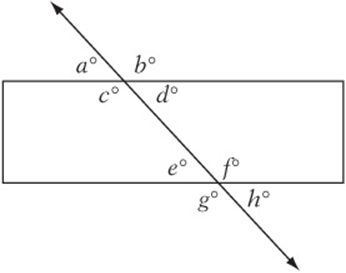
3. The figure above shows a rectangle intersected by a line. If ![]() , then
, then ![]()
(A) 120
(B) 240
(C) 300
(D) 320
(E) 360
4. For all real numbers x where ![]() , let
, let ![]() What is the value of f (100)?
What is the value of f (100)?
(A) 3
(B) 9
(C) 10
(D) 27
(E) 100
5. If ![]() and
and ![]() , then what is the value of 2k?
, then what is the value of 2k?
(A) 2
(B) 4
(C) 6
(D) 8
(E) 10
6. If b varies inversely as the square of c, and if ![]() when
when ![]() , then what could be the value of c when
, then what could be the value of c when ![]()
(A) 2
(B) 5
(C) 6
(D) 25
(E) 36
7. In a certain soccer league, each of the five teams plays every other team in the league exactly three times each season. How many games are played in total in one season?
(A) 15
(B) 24
(C) 30
(D) 60
(E) 120
8. Pump A, working alone, can fill a tank in 3 hours, and pump B can fill the same tank in 2 hours. If the tank is empty to start and pump A is switched on for one hour, after which pump B is also switched on and the two work together, how many minutes will pump B have been working by the time the tank is filled?
(A) 48
(B) 50
(C) 54
(D) 60
(E) 64
Directions: For student-produced response questions 9–18, use the grids at the bottom of the answer sheet page on which you have answered questions 1–8.
Each of the remaining ten questions requires you to solve the problem and enter your answer by marking the circles in the special grid, as shown in the examples below. You may use any available space for scratchwork.
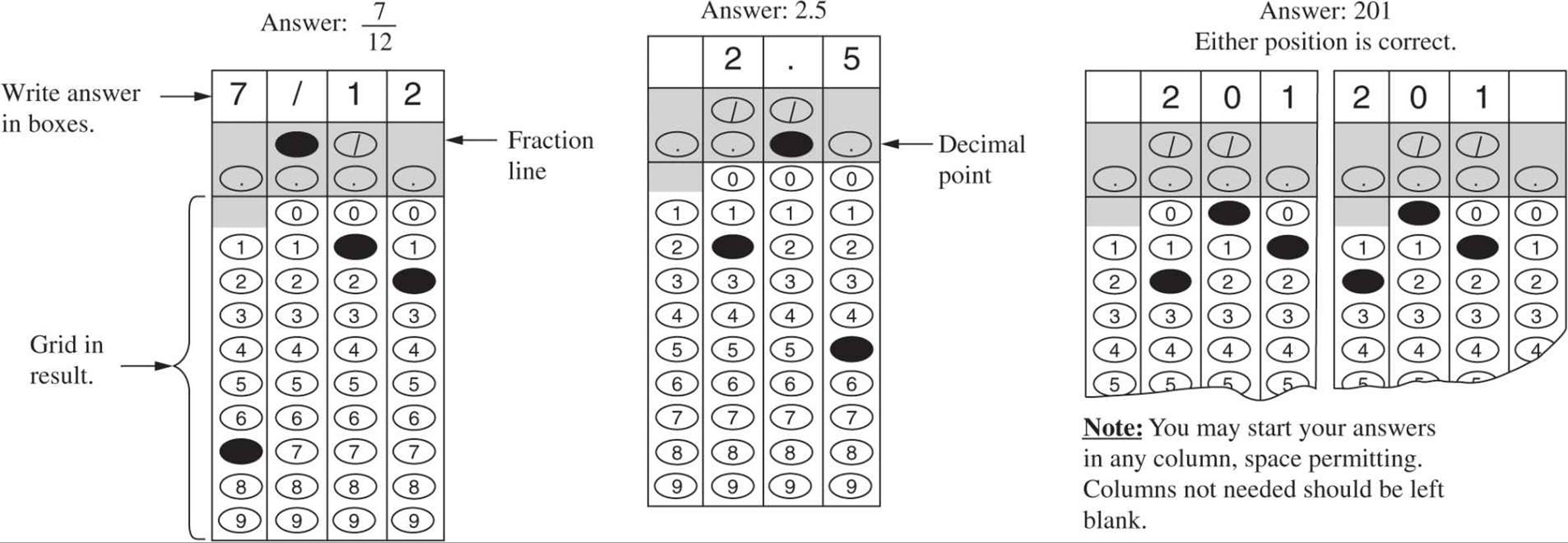
• Mark no more than one circle in any column.
• Because the answer sheet will be machine-scored, you will receive credit only if the circles are filled in correctly.
• Although not required, it is suggested that you write your answer in the boxes at the top of the columns to help you fill in the circles accurately.
• Some problems may have more than one correct answer. In such cases, grid only one answer.
• No question has a negative answer.
• Mixed numbers such as ![]() must be gridded as 3.5 or 7/2. (If
must be gridded as 3.5 or 7/2. (If  is gridded, it will be interpreted as,
is gridded, it will be interpreted as, ![]() not
not ![]() )
)
• Decimal Answers: If you obtain a decimal answer with more digits than the grid can accommodate, it may be either rounded or truncated, but it must fill the entire grid. For example, if you obtain an answer such as 0.6666…, you should record your result as .666 or .667. A less accurate value such as .66 or .67 will be scored as incorrect.
Acceptable ways to grid ![]() are:
are:
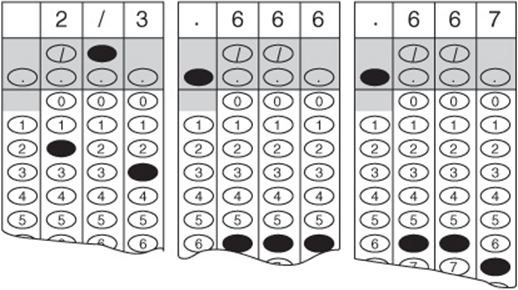
9. If four times a certain number is decreased by 5, the result is 25. What is the number?
10. For every integer m greater than 1, let «m» be defined as the sum of the integers from 1 to m, inclusive. For instance, ![]() .
.
What is the value of ![]()
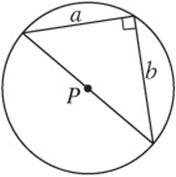
11. If the circumference of the circle above is 10π, then what is the value of a2+b2?
A, B, C, D
12. How many different three-letter arrangements of the letters above are possible if no letter may be repeated? (An arrangement like ABC is distinct from an arrangement like BCA.)
13. If ![]() , then
, then 
14. Every term in a certain sequence is one less than three times the previous term. If the fourth term of this sequence is 95, what is the first term of the sequence?
15. If ![]() , what is the value of
, what is the value of ![]()
16. Admission to a museum is $10 for each adult and $5 for each child. If a group of 30 people pays a total of $175 in admission, how many adults are in the group?
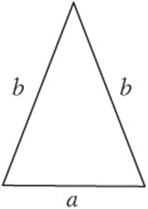
17. The perimeter of the isosceles triangle above is 24. If the ratio of a to b is 2 to 3, what is the value of b?
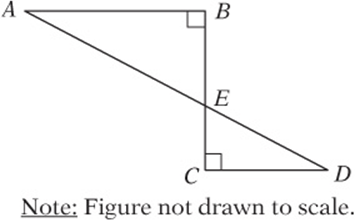
18. In the figure above, ![]() ,
, ![]() , and
, and ![]() . What is AD?
. What is AD?

If you finish before time is called, you may check your work on this section only. Do not turn to any other section of the test.
SECTION 6
Time—25 minutes
24 questions
Turn to Section 6 of your answer sheet to answer the questions in this section.
Directions: For each question in this section, select the best answer from among the choices given and fill in the corresponding circle on the answer sheet.
Each sentence below has one or two blanks, each blank indicating that something has been omitted. Beneath the sentence are five words or sets of words labeled A through E. Choose the word or set of words that, when inserted in the sentence, best fits the meaning of the sentence as a whole.
EXAMPLE:
Rather than accepting the theory unquestioningly, Deborah regarded it with -----.
(A) mirth
(B) sadness
(C) responsibility
(D) ignorance
(E) skepticism
![]()
1. The strange signal detected by the radio telescope, rather than being taken as evidence of a new cosmological phenomenon, was instead treated as merely ------- of the equipment itself.
(A) a malfunction
(B) a bulwark
(C) an anthology
(D) a mutation
(E) a transfer
2. The long-standing divisions among the indigenous ethnic groups in the region have created an ------- problem that may never be solved without international intervention.
(A) impotent
(B) intractable
(C) evanescent
(D) irate
(E) insipid
3. The ease with which the army”s defenses were breached surprised the opposing general, who expected resistance to be far more ------- than it was.
(A) ephemeral
(B) compatible
(C) egregious
(D) tolerable
(E) imposing
4. Although dependence on electronic devices has ------- in recent years, the increased efficiency of common appliances has ------- the demand on the power grid.
(A) abated . . decreased
(B) surged . . attenuated
(C) increased . . compromised
(D) diminished . . reduced
(E) flourished . . elevated
5. Although persecution at the hands of ------- landowners vanquished the will of many, it ------- the dreams of revolution among the hardier insurgents.
(A) despotic . . squandered
(B) cruel . . destroyed
(C) amenable . . bore
(D) celebrated . . initiated
(E) ruthless . . forged
The passages below are followed by questions based on their content; questions following a pair of related passages may also be based on the relationship between the paired passages. Answer the questions on the basis of what is stated or implied in the passage and in any introductory material that may be provided.
Questions 6–9 are based on the following passages.
PASSAGE 1
The following is from a recent commentary on Jean-Jacques Rousseau (1712–1778), a French philosopher during the Enlightenment.
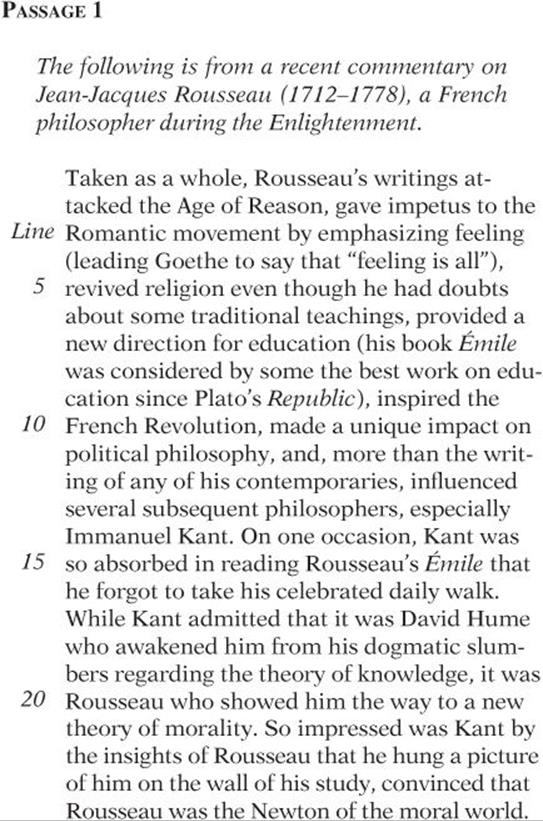
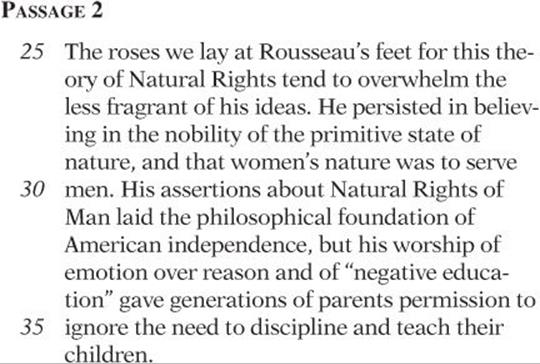
First passage: from “Rousseau: A Romantic in the Age of Reason,” from Socrates to Sartre, McGraw-Hill, 1999, p. 278
Second passage: Copyright 2005 Christopher Black. All rights reserved.
6. Passage 1 suggests that Goethe
(A) was at the forefront of the Age of Reason
(B) was a traditionalist
(C) was influenced by Rousseau
(D) opposed the Romantic movement
(E) inspired much of Rousseau”s work
7. Passage 1 mentions Kant”s “daily walk” (line 16) in order to emphasize
(A) Kant”s forgetfulness
(B) Kant”s commitment to healthful practices
(C) the dogmatic nature of Rousseau”s writings
(D) the effect of Rousseau”s philosophy on Kant
(E) Kant”s close friendship with Rousseau
8. Unlike Passage 1, Passage 2 characterizes Rousseau”s emphasis on emotion as
(A) insincere
(B) innovative
(C) harmful
(D) temporary
(E) necessary
9. Both passages credit Rousseau with
(A) attacking the Age of Reason
(B) inspiring revolutionary thought
(C) encouraging discipline
(D) praising the primitive state of nature
(E) establishing the Romantic movement
Questions 10–16 are based on the following passage.
The following passage was written by an American essayist in 2003 about the status of capitalism.
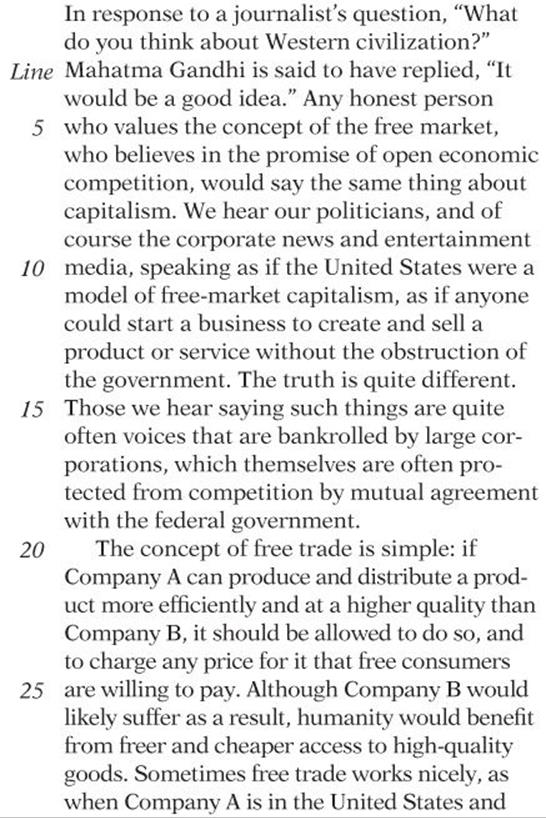
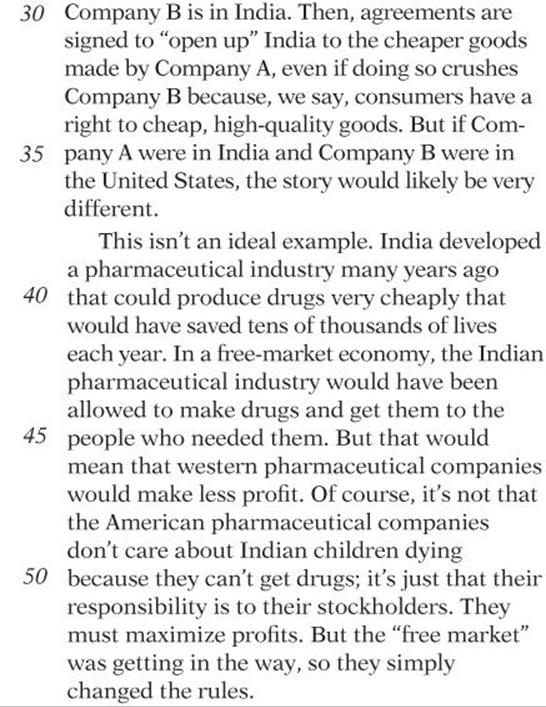
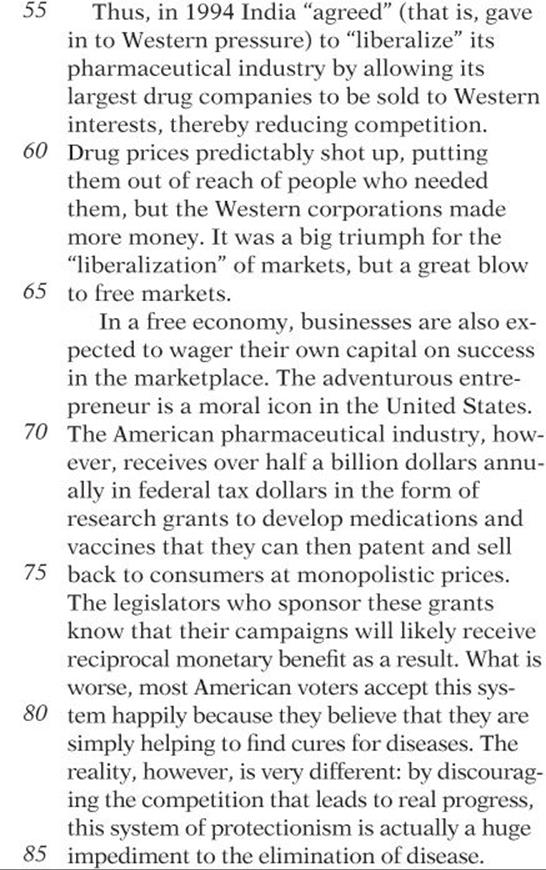
10. The quotation from Mahatma Gandhi (lines 3–4) suggests that Gandhi believed that Western civilization was
(A) on the decline
(B) the beneficiary of unfair economic practices
(C) antithetical to progress in Asia
(D) a great triumph
(E) an unrealized concept
11. The “voices” mentioned in line 16 can be inferred to include all of the following EXCEPT
(A) American politicians
(B) leaders like Mahatma Gandhi
(C) television journalists
(D) some leaders of large corporations
(E) those who believe that the United States is faithful to the capitalist ideal
12. The primary function of the second paragraph (lines 20–37) is to
(A) illustrate a debate
(B) provide a statistical analysis
(C) explain a concept
(D) give historical background
(E) describe a popular viewpoint
13. By saying that “the story would likely be very different” (lines 36–37), the passage suggests that
(A) the rules of a free market are selectively applied
(B) trade laws favor smaller countries
(C) American companies produce the best products
(D) Asian countries are moving away from the free market
(E) American companies share the same interests as Indian companies
14. The quotation marks around particular words in the fourth paragraph (lines 55–65) serve primarily to indicate that those words are
(A) being used ironically
(B) technical economic terms
(C) adaptations of foreign words
(D) recently coined
(E) direct quotations from a document described earlier
15. The “triumph” described in line 63 is characterized as
(A) a rare success for free markets
(B) a legislative victory
(C) a breakthrough in the development of inexpensive drugs
(D) a tragic violation of the principle of free trade
(E) a success that was based on luck
16. The passage suggests that the “entrepreneur” (lines 68–69) differs from executives in the pharmaceutical industry in that the entrepreneur
(A) does not abide by free-market ideals
(B) risks his or her own money
(C) does not hire employees from overseas
(D) works more closely with representatives in Washington
(E) needs less money to start a typical business
Questions 17–24 are based on the following passage.
The following passage is an excerpt from Mary Shelley”s Frankenstein, written in 1831.
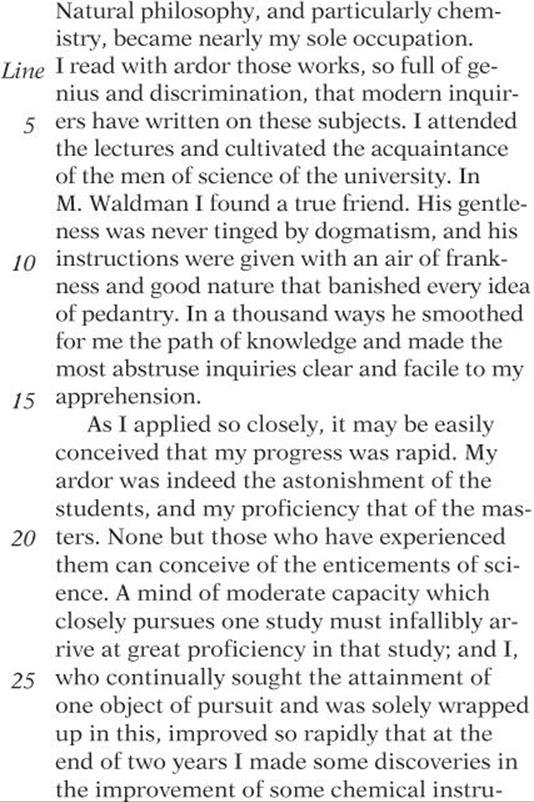
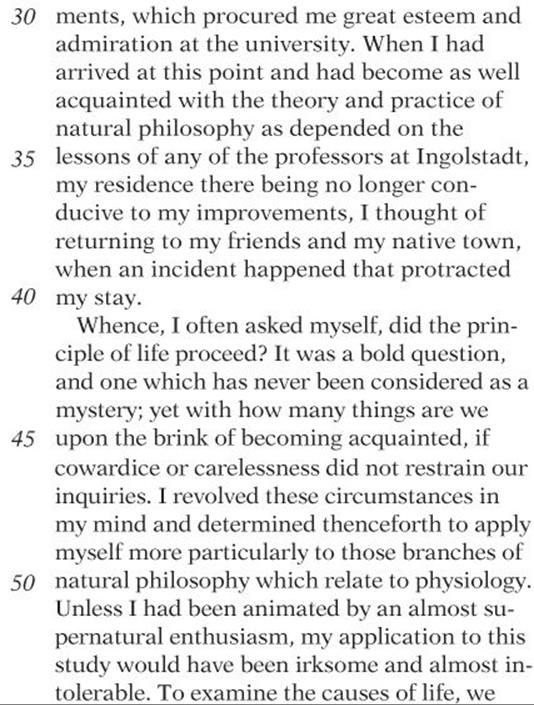
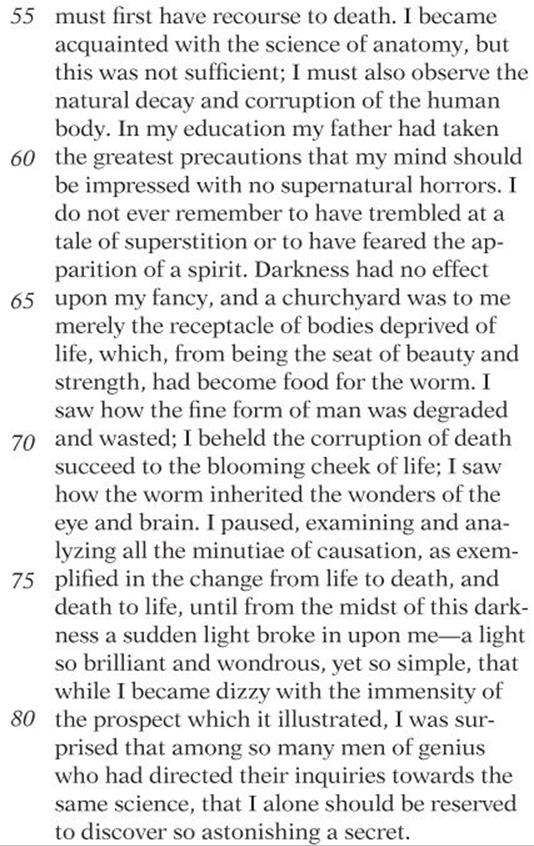
Excerpted from Frankenstein by Mary Shelley, public domain, edited for length
17. In the first paragraph, the narrator indicates that the instruction given to him by M. Waldman was
(A) haughty
(B) challenging
(C) easily understood
(D) obscure
(E) expensive
18. In line 15, the word “apprehension” most nearly means
(A) fear
(B) reservation
(C) imprisonment
(D) understanding
(E) arrest
19. The narrator indicates that proficiency in an academic study requires which of the following?
I. genius
II. diligence
III. financial resources
(A) I only
(B) II only
(C) I and II only
(D) I and III only
(E) I, II, and III
20. The narrator indicates that he considered leaving Ingolstadt because he
(A) had learned all he could from its instructors
(B) was acutely homesick
(C) was offered another job
(D) had a negative experience with a professor there
(E) had become ill
21. In saying that he was “animated by an almost supernatural enthusiasm” (lines 51–52), the narrator suggests that he
(A) was easily influenced by superstition
(B) loved lecturing at Ingolstadt
(C) was passionate about studying the physiology of life and death
(D) was excited about the prospect of returning home
(E) wanted to learn more about the origin of certain superstitions
22. The “seat of beauty and strength” (lines 67–68) is a reference to
(A) the churchyard
(B) the human body
(C) the worm
(D) the university at Ingolstadt
(E) the narrator”s studies
23. In line 71, the phrase “succeed to” most nearly means
(A) inspire
(B) thrive
(C) replace
(D) proceed to
(E) promote
24. The final sentence of the passage suggests that the narrator feels
(A) intimidated by the enormous task before him
(B) grateful to those who instructed him
(C) anxious about the moral dilemma posed by his work
(D) baffled by particular scientific principles
(E) privileged to be on the verge of a momentous discovery

If you finish before time is called, you may check your work on this section only. Do not turn to any other section of the test.
SECTION 7
Time—20 minutes
16 questions
Turn to Section 7 of your answer sheet to answer the questions in this section.
Directions: For this section, solve each problem and decide which is the best of the choices given. Fill in the corresponding circle on the answer sheet. You may use any available space for scratchwork.
Notes
1. The use of a calculator is permitted.
2. All numbers used are real numbers.
3. Figures that accompany problems in this test are intended to provide information useful in solving the problems. They are drawn as accurately as possible EXCEPT when it is stated in a specific problem that the figure is not drawn to scale. All figures lie in a plane unless otherwise indicated.
4. Unless otherwise specified, the domain of any function f is assumed to be the set of all real numbers x for which f (x) is a real number.
Reference Information

The number of degrees of arc in a circle is 360.
The sum of the measures in degrees of the angles of a triangle is 180.
1. Which of the following integers is 2 greater than a multiple of 7?
(A) 14
(B) 15
(C) 16
(D) 17
(E) 18
2. A store sells oranges for 20 cents each, but for every four oranges you buy, you may buy a fifth for only 5 cents. How many oranges can you buy from this store for $3.40?
(A) 14
(B) 17
(C) 18
(D) 19
(E) 20
3. If r is a positive number and s is a negative number, all of the following must represent positive numbers EXCEPT.
![]()
![]()
![]()
(D) r s2
(E) (rs)2
4. Which of the following expresses the number that is 12 less than the product of 3 and ![]() ?
?
![]()
![]()
![]()
![]()
![]()
5. One bag of grass seed covers 5,000 square feet. If each bag costs $25, how much will it cost to buy enough grass seed to cover a square area that is 200 feet by 200 feet?
(A) $25
(B) $100
(C) $200
(D) $1,000
(E) $2,000
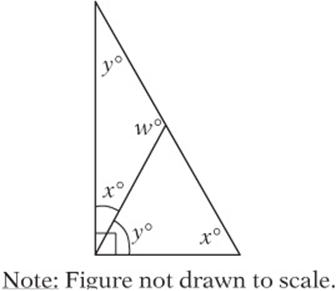
6. In the right triangle above, what is the value of w?
(A) 30
(B) 60
(C) 90
(D) 120
(E) 150
7. Three integers have a sum of 7 and a product of 0. If the difference of the greatest number and the least number is 11, then the least of these numbers is
(A) –18
(B) –11
(C) –9
(D) –2
(E) 0
8. Four points lie on a circle. How many different triangles can be drawn with three of these points as vertices?
(A) 4
(B) 5
(C) 6
(D) 7
(E) 8
9. If a, b, and c are consecutive positive integers such that ![]() and abc is NOT a multiple of 4, then which of the following must be true?
and abc is NOT a multiple of 4, then which of the following must be true?
(A) a is even
(B) b is even
(C) c is even
(D) a + b + c is odd
(E) abc is odd
Questions 10–12 refer to the following graph.
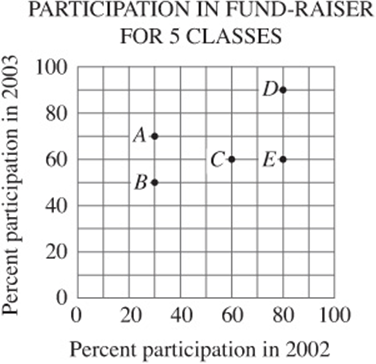
10. For which class was the change in percent participation the greatest from 2002 to 2003?
(A) A
(B) B
(C) C
(D) D
(E) E
11. If class B and class E each had 100 students in 2002 and 2003, then, in total, how many more students participated in the fund-raiser from class E than from class B over the 2 years?
(A) 10
(B) 20
(C) 30
(D) 40
(E) 60
12. In 2002, the same number of students participated in the fund-raiser from class C as from class D. If class D contained 120 students in 2002, how many students were there in class C in 2002?
(A) 90
(B) 100
(C) 120
(D) 140
(E) 160
13. If ![]() is a solution of the equation
is a solution of the equation ![]() where c is a constant, what is another value of x that satisfies the equation?
where c is a constant, what is another value of x that satisfies the equation?
(A) –5
(B) –2
(C) 1
(D) 2
(E) 5
1, 2, 6, 7, 9
14. A three-digit integer is to be formed from the digits listed above. If the first digit must be odd, either the second or the third digit must be 2, and no digit may be repeated, how many such integers are possible?
(A) 6
(B) 9
(C) 18
(D) 24
(E) 30
15. If one pound of grain can feed five chickens or two pigs, then ten pounds of grain can feed 20 chickens and how many pigs?
(A) 8
(B) 10
(C) 12
(D) 24
(E) 40
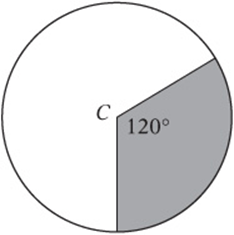
16. Point C is the center of the circle on the figure above. The shaded region has an area of 3s square centimeters. What is the perimeter of the shaded region in centimeters?
![]()
![]()
![]()
![]()
![]()

If you finish before time is called, you may check your work on this section only. Do not turn to any other section of the test.
SECTION 8
Time—20 minutes
19 questions
Turn to Section 8 of your answer sheet to answer the questions in this section.
Directions: For each question in this section, select the best answer from among the choices given and fill in the corresponding circle on the answer sheet.
Each sentence below has one or two blanks, each blank indicating that something has been omitted. Beneath the sentence are five words or sets of words labeled A through E. Choose the word or set of words that, when inserted in the sentence, best fits the meaning of the sentence as a whole.
EXAMPLE:
Rather than accepting the theory unquestioningly, Deborah regarded it with-----.
(A) mirth
(B) sadness
(C) responsibility
(D) ignorance
(E) skepticism
![]()
1. The studio”s most recent movies reflect a ------- of many different artistic visions rather than the ------- of a single director.
(A) conglomeration . . insubordination
(B) prudence . . unity
(C) bastion . . despair
(D) synthesis . . dominance
(E) conspiracy . . retreat
2. Rather than endeavoring to write timeless fiction with lasting value, many novelists cater to the ------- tastes of those modern readers who read a book once and then discard it.
(A) immoral
(B) fleeting
(C) valuable
(D) solid
(E) intellectual
3. Although many investors may tolerate short-term declines in the value of their securities, few will accept a ------- downturn in the stock market.
(A) protracted
(B) contemporaneous
(C) transient
(D) surreptitious
(E) fickle
4. In most modern societies, athletes are ------- in the same way that successful warriors were celebrated by civilizations in years past.
(A) invoked
(B) repudiated
(C) lionized
(D) vilified
(E) beguiled
5. Dobson”s overconfident and arrogant manner during press conferences was beginning to irritate his associates; there was no need to be ------- about the success of an endeavor that had yet to be launched.
(A) superficial
(B) capricious
(C) pious
(D) deferential
(E) supercilious
6. Although few literary critics approved of her criticism of the ------- society in which she lived, Virginia Woolf remained a ------- opponent of the male hegemony that hindered women”s pursuit of professional and artistic success.
(A) matriarchal . . pugnacious
(B) patriarchal . . vociferous
(C) avuncular . . belligerent
(D) prejudiced . . rudimentary
(E) liberal . . negligent
The passages below are followed by questions based on their content. Answer the questions on the basis of what is stated or implied in the passage and in any introductory material that may be provided.
Questions 7–19 are based on the following passage.
The following are two essays on the American English spelling reform movement. Passage 1 was written in 1906 by the humorist Ellis Parker Butler. Passage 2 was written by a modern American writer in 2003.
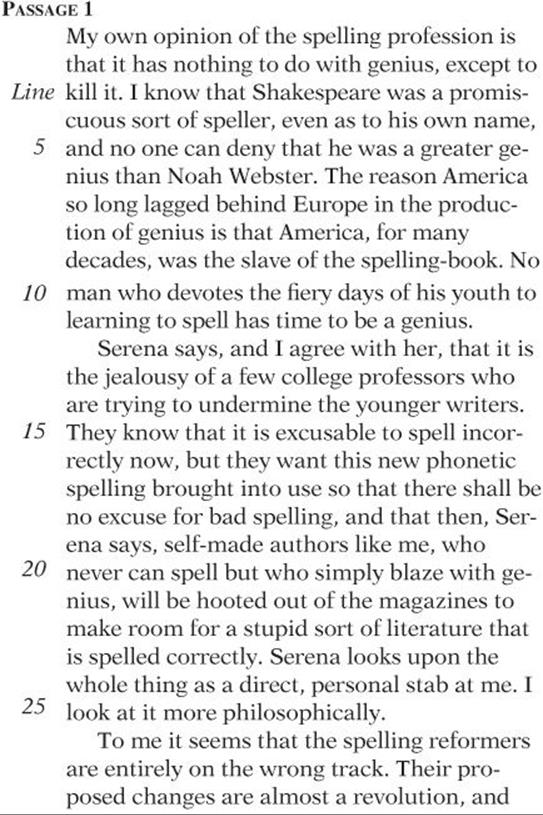
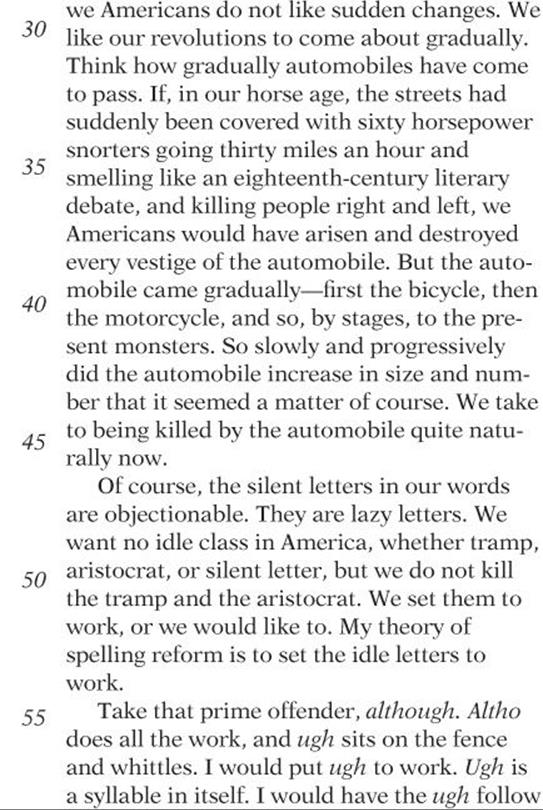
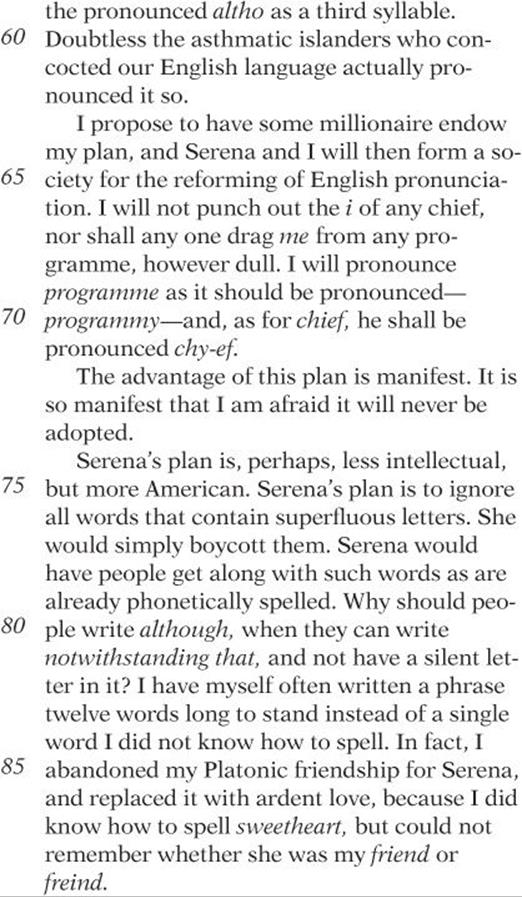
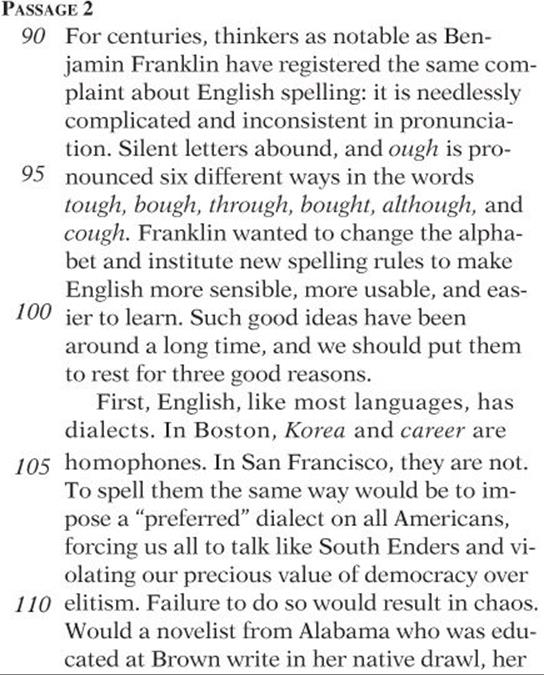
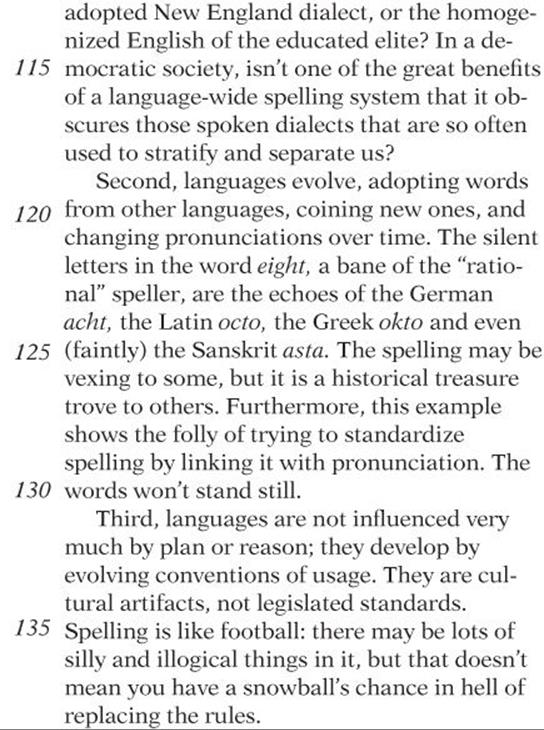
7. In the first paragraph of Passage 1, Noah Webster is mentioned as an example of
(A) a genius who was a poor speller
(B) one of the first spelling reformers
(C) a man devoted to proper spelling
(D) a famous playwright
(E) one who shares the author”s opinion
8. Serena regards phonetic spelling as a “personal stab” (line 24) at the author of Passage 1 because its proponents
(A) have a history of vindictiveness
(B) do not like hard work
(C) are well educated
(D) are wealthy
(E) want to eliminate the author”s excuse for poor spelling
9. The success of “Serena”s plan” (line 74) depends on the ability of people to
(A) change their habits of pronunciation
(B) spell correctly
(C) perfect their handwriting skills
(D) learn an entirely new alphabet
(E) change their writing habits
10. By saying that Serena”s plan is “more American” (line 75), the author of Passage 1 implies that Americans
(A) are good spellers
(B) regard writers with disdain
(C) are inclined to protest
(D) do not read enough
(E) can”t take a joke
11. In Passage 1, the author”s theory of spelling reform differs from that of Serena in that the author
(A) wants to alter the pronunciation of words that Serena wants to ignore
(B) regards Shakespeare as a genius but Serena does not
(C) wants to change the alphabet but Serena does not
(D) seeks to simplify spelling, while Serena does not
(E) understands how to alter American habits but Serena does not
12. The author of Passage 1 claims to have fallen in love with Serena because
(A) his spelling skills were weak
(B) they agreed on a plan for phonetic spelling
(C) she helped him to understand philosophy
(D) they shared a distaste for automobiles
(E) they were both writers
13. The “chaos” mentioned in line 110 refers to
(A) the difficulty of spelling words with silent letters
(B) the challenge of getting scholars to agree
(C) the many ways of pronouncing ough
(D) the possibility of many sets of spelling rules for different dialects
(E) the disagreement among linguists regarding spelling reform
14. According to Passage 2, “one of the great benefits of a language-wide spelling system” (lines 115–116) is that it
(A) simplifies commonly misspelled words
(B) discourages social distinctions implied by pronunciation
(C) eliminates silent letters
(D) makes it easier to translate words from English to other languages
(E) imposes a preferred dialect
15. Passage 2 mentions the word “eight” (line 122) as an example of
(A) a word with a spelling that is edifying to some
(B) a commonly mispronounced word
(C) a word with a spelling that the author believes should be simplified
(D) a recently coined term
(E) a word that has remained unchanged for centuries
16. The tone of the two passages differs in that Passage 1 is
(A) jocular, whereas Passage 2 is logical
(B) cynical, whereas Passage 2 is whimsical
(C) analytical, whereas Passage 2 is lighthearted
(D) scientific, whereas Passage 2 is satirical
(E) strident, whereas Passage 2 is reflective
17. With which of the following statements would the authors of both passages most likely agree?
(A) The rules of English spelling need to be changed.
(B) Modern conventions of grammar are illogical.
(C) Americans are lazy.
(D) Conventions of language are not easily changed.
(E) Writers should read widely to perfect their craft.
18. If the author of Passage 1 were serious about his plan for reforming English pronunciation, the author of Passage 2 would likely regard that plan as
(A) a necessary addition to phonetic spelling
(B) a logical alternative to the current system
(C) inferior to the plan for phonetic spelling
(D) unworkable because it disregards the way that conventions of language develop
(E) a more plausible plan than Serena”s
19. In both passages, the word “although” is regarded as
(A) a word that is commonly mispronounced
(B) a word that is difficult to spell
(C) an example of an idiosyncracy of English that some consider problematic
(D) a word that reveals much about the development of the English language
(E) a word that can easily be eliminated from the English language

If you finish before time is called, you may check your work on this section only. Do not turn to any other section of the test.
SECTION 9
Time—10 minutes
14 questions
Turn to Section 9 of your answer sheet to answer the questions in this section.
Directions: For each question in this section, select the best answer from among the choices given and fill in the corresponding circle on the answer sheet.
The following sentences test correctness and effectiveness of expression. Part of each sentence or the entire sentence is underlined; beneath each sentence are five ways of phrasing the underlined material. Choice A repeats the original phrasing; the other four choices are different. Select the choice that completes the sentence most effectively.
In making your selection, follow the requirements of standard written English; that is, pay attention to grammar, choice of words, sentence construction, and punctuation. Your selection should result in the most effective sentence—clear and precise, without awkwardness or ambiguity.
EXAMPLE:
The children couldn”t hardly believe their eyes.
(A) couldn”t hardly believe their eyes
(B) could hardly believe their eyes
(C) would not hardly believe their eyes
(D) couldn”t nearly believe their eyes
(E) couldn”t hardly believe his or her eyes
![]()
1. The chef”s assistant cut the vegetables and laid them on the table, he then started to prepare the meat.
(A) The chef”s assistant cut the vegetables and laid them on the table, he
(B) The vegetables were cut and laid on the table by the chef”s assistant when he
(C) After cutting the vegetables and laying them on the table, the chef”s assistant
(D) The chef”s assistant, having cut the vegetables and laying them on the table,
(E) Laying on the table, the chef”s assistant who cut the vegetables
2. Practicing their rebuttals ahead of time helps the forensics team members to become a better debater.
(A) helps the forensics team member to become a better debater
(B) helps forensic team members to become better debaters
(C) helping the forensics team members to become better debaters
(D) is helpful to the forensics team members who become better debaters
(E) the forensics team member becomes a better debater
3.Billy the Bobcat, like other children”s stories, have elements that can only be fully appreciated by adults.
(A) like other children”s stories have
(B) like other children”s stories, has
(C) a children”s story, like others, has
(D) is like other stories for children in that they have
(E) like that of other children”s stories, has also
4. Ernest Rutherford, a scientist when measuring the charge and mass of alpha particles, discovered that they are virtually identical to the nuclei of helium atoms.
(A) a scientist when measuring the charge and mass of alpha particles
(B) a scientist who measured the charge and mass of alpha particles
(C) a scientist which measured the charge and mass of alpha particles
(D) measuring the charge and mass of alpha particles, was a scientist when he
(E) being the one who measured the mass and charge of alpha particles as a scientist
5. Oxytocin is the hormone that triggers uterine contractions during labor, as well as the preliminary contractions known as Braxton Hicks.
(A) labor, as well as
(B) labor, as well as being the hormone that triggers
(C) labor, causing as well
(D) labor; and also causes
(E) labor; also causing
6. During the Clinton presidency, the U.S. enjoyed more than any time in its history peace and economic well being.
(A) the U.S. enjoyed more than any time in its history peace and economic well being
(B) the U.S. enjoying more than any other time in its history peace and economic well being
(C) more peace and economic well being was enjoyed by the U.S. than any other time
(D) economic peace and well being was enjoyed by the U.S. more so than any other time in the country”s history
(E) the U.S. enjoyed more peace and economic well being than at any other time in its history
7. The final three months of the year tend to be profitable for technology companies because of increased consumer demand being around the holidays.
(A) because of increased consumer demand being around the holidays
(B) because of increasing consumer demand occurs around the holidays
(C) an increased consumer demand around the holidays makes it so
(D) because consumer demand increases around the holidays
(E) because the increased consumer demand is what occurs around the holidays
8. As his moviemaking career began to wane, Jerry Lewis remained in the public eye by hosting both a variety show and on an annual telethon with benefits for the Muscular Dystrophy Association.
(A) on an annual telethon with benefits for the Muscular Dystrophy Association
(B) an annual telethon with benefits to the Muscular Dystrophy Association
(C) benefiting the Muscular Dystrophy Association with his annual telethon
(D) an annual telethon benefiting the Muscular Dystrophy Association
(E) the Muscular Dystrophy Association with an annual telethon
9. The development of bebop is attributed in large part to Dizzy Gillespie and also saxophonist Charlie Parker; and their unique styles helped to contribute to and typified the bebop sound.
(A) and their unique styles helped to contribute to and typified the bebop sound
(B) their unique styles contributed to and typified the bebop sound
(C) it was their unique styles that contributed to and were typifying the bebop sound
(D) but their unique styles helped contribute to the typical bebop sound
(E) the bebop sound was helped by the contributions of their unique styles and typified it
10. Many critics believe that video games are harmful to children that contain violent imagery.
(A) are harmful to children that contain violent imagery
(B) containing violent imagery are harmful to children
(C) that contain violent imagery that harms children
(D) containing violent imagery that are harmful to children
(E) harmful to children containing violent imagery
11. Walking hand-in-hand along the boardwalk, a vendor stopped the couple to try to sell them lemonade.
(A) a vendor stopped the couple to try to sell them lemonade
(B) the couple was stopped by a vendor who tried to sell them lemonade
(C) trying to sell them lemonade, a vendor stopped the couple
(D) a vendor stopped the couple to try and sell them lemonade
(E) the couple having been stopped by the vendor who tried to sell them lemonade
12. Professor Peterson had just stepped into the classroom and that was when he discovered that several lab manuals were missing.
(A) and that was when he found out
(B) and then he discovered
(C) when he discovered
(D) after which he discovered
(E) discovering soon thereafter
13. Parents today spend more time working than 30 years ago.
(A) than
(B) than have
(C) than of the parents of
(D) than did parents
(E) than of the parents
14. The anthropologists would have considered their research a success if they would have found a language that shares lexical elements with the Borneans they were studying.
(A) if they would have found a language that shares lexical elements with the Borneans they were studying
(B) had they found a language that shares lexical elements with that of the Borneans they were studying
(C) if they found a language that shares lexical elements with the Borneans they were studying
(D) if they had found a language that shares lexical elements with the Borneans they were studying
(E) if they would have found a language that shares lexical elements with that of the Borneans they were studying

If you finish before time is called, you may check your work on this section only. Do not turn to any other section of the test.
ANSWER KEY
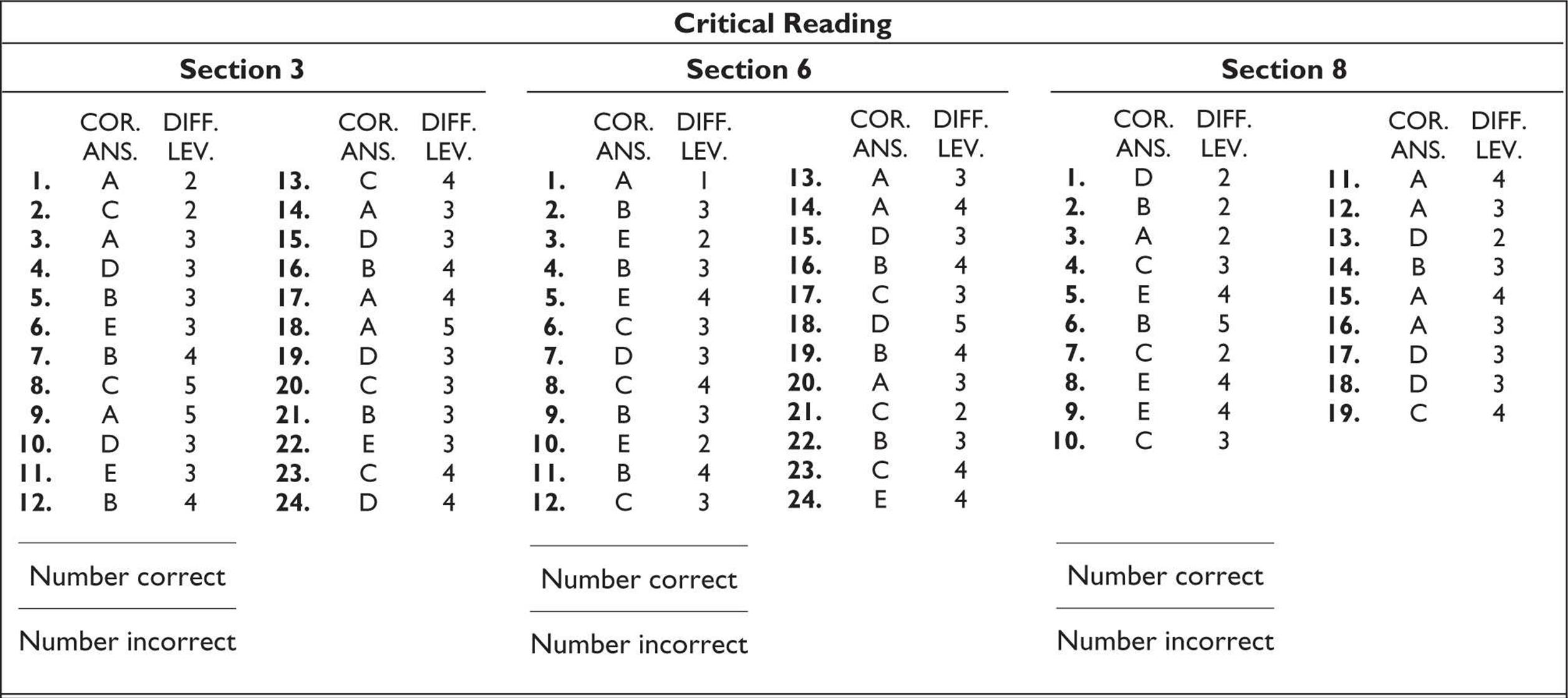
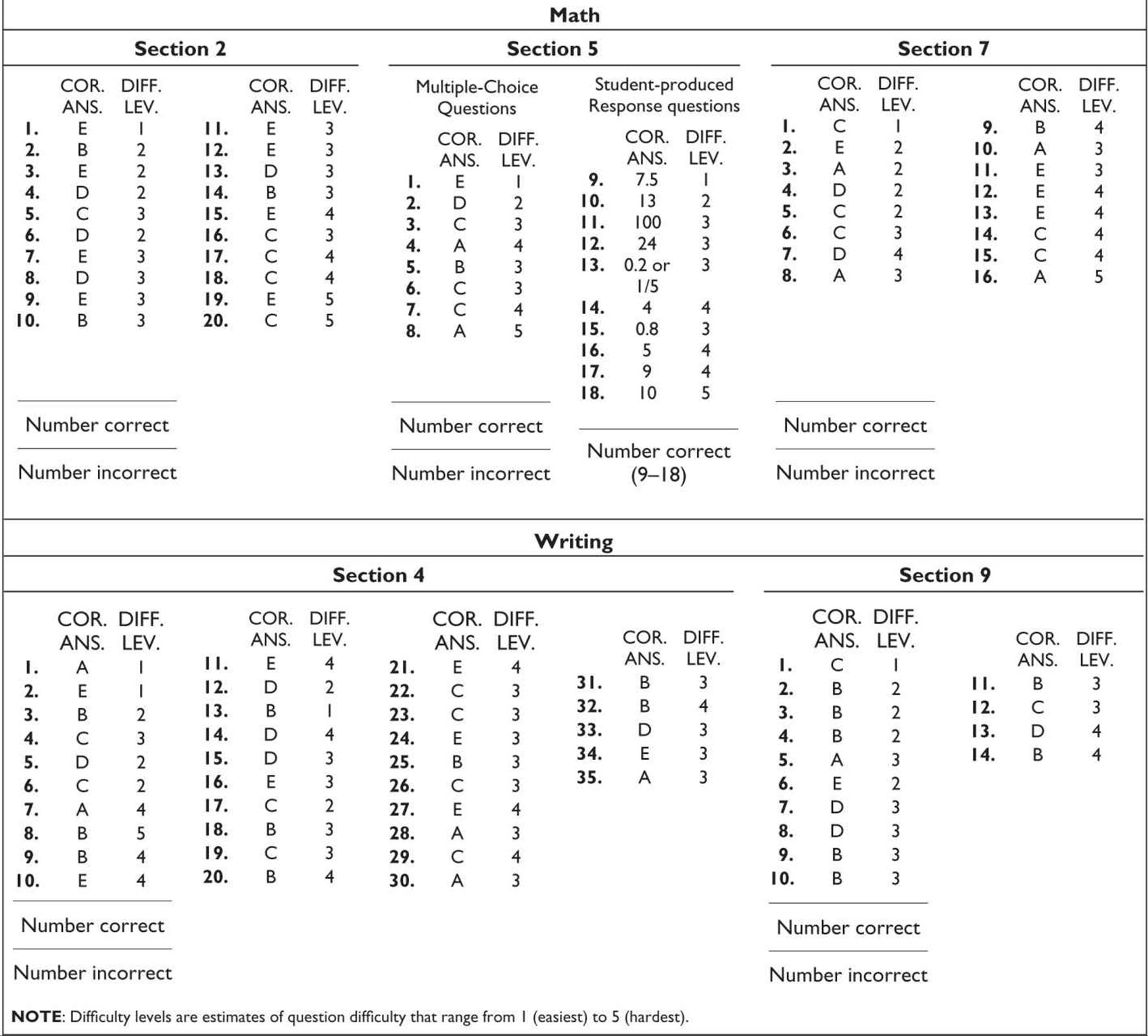
SCORE CONVERSION TABLE
How to score your test
Use the answer key on the previous page to determine your raw score on each section. Your raw score on each section except Section 5 is simply the number of correct answers minus ¼ of the number of wrong answers. On Section 5, your raw score is the sum of the number of correct answers for questions 1–18 minus ¼ of the number of wrong answers for questions 1–8. Next, add the raw scores from Sections 3, 6, and 8 to get your Critical Reading raw score, add the raw scores from Sections 2, 5, and 7 to get your Math raw score, and add the raw scores from Sections 4 and 9 to get your Writing raw score.
Raw Critical Reading score: ____________ Raw Math score: ____________ Raw Writing score: ___________
Use the table below to convert these to scaled scores.
Scaled scores: Critical Reading: _____________ Math: _____________ Writing: _____________
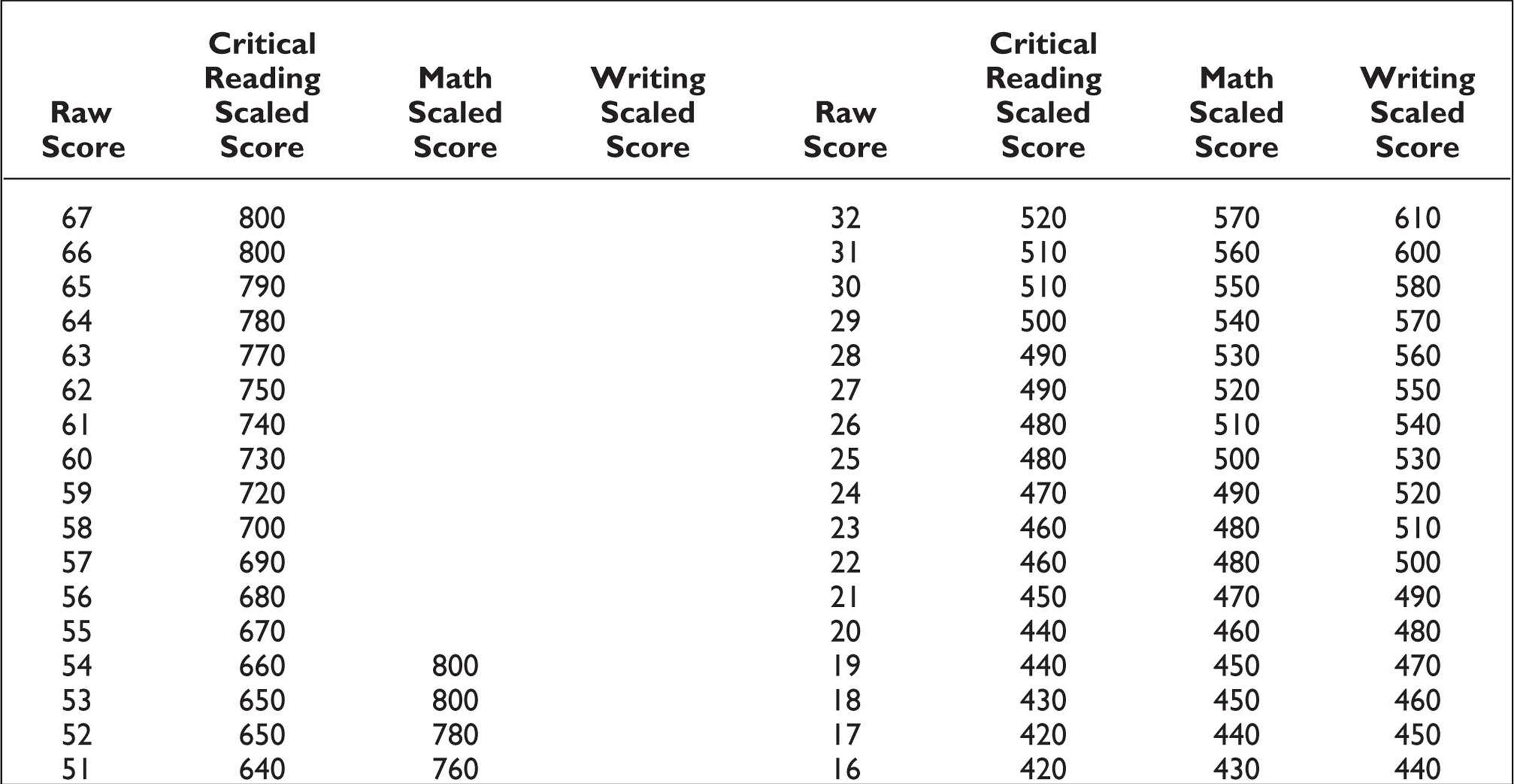
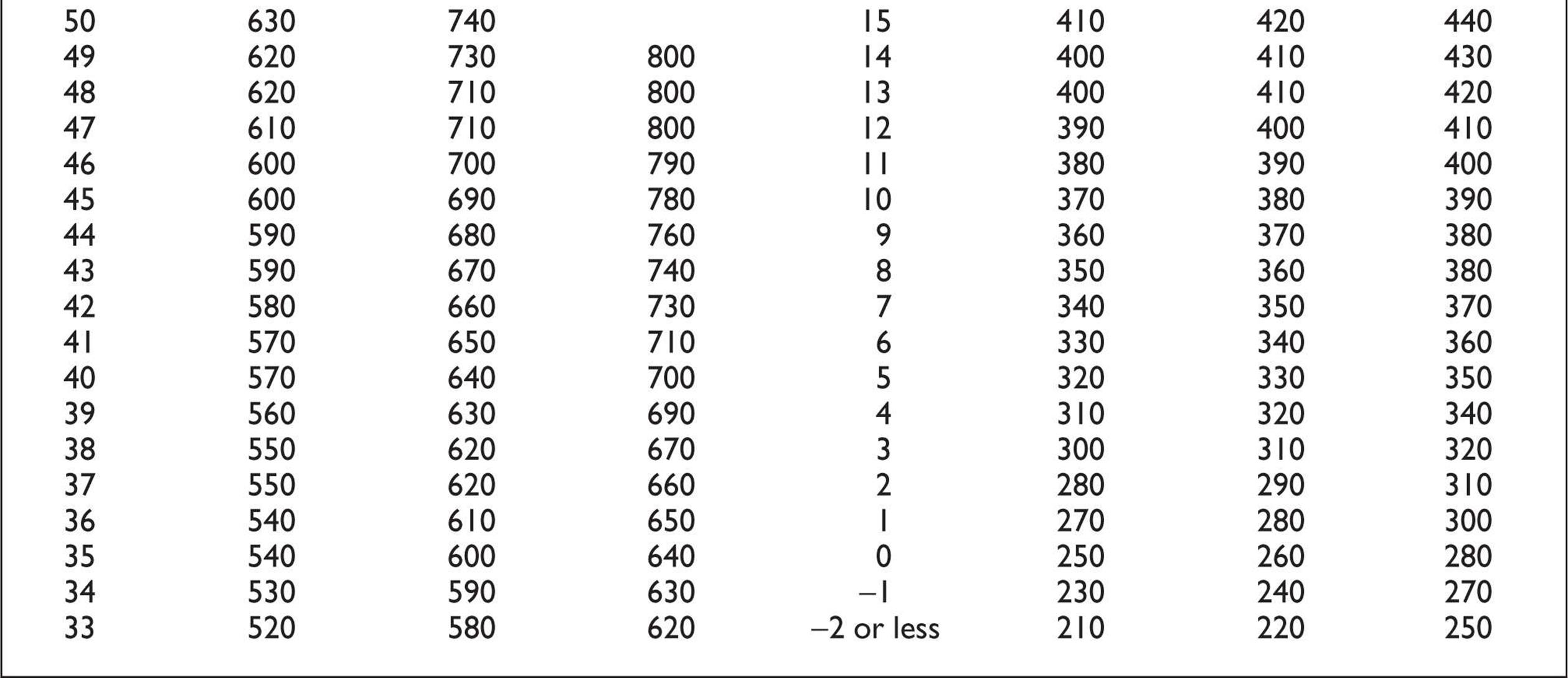
SCORE CONVERSION TABLE FOR WRITING COMPOSITE [ESSAY + MULTIPLE CHOICE]
Calculate your Writing raw score as you did on the previous page and grade your essay from a 1 to a 6 according to the standards that follow in the detailed answer key.
Essay score: ____________ Raw Writing score: ____________
Use the table below to convert these to scaled scores.
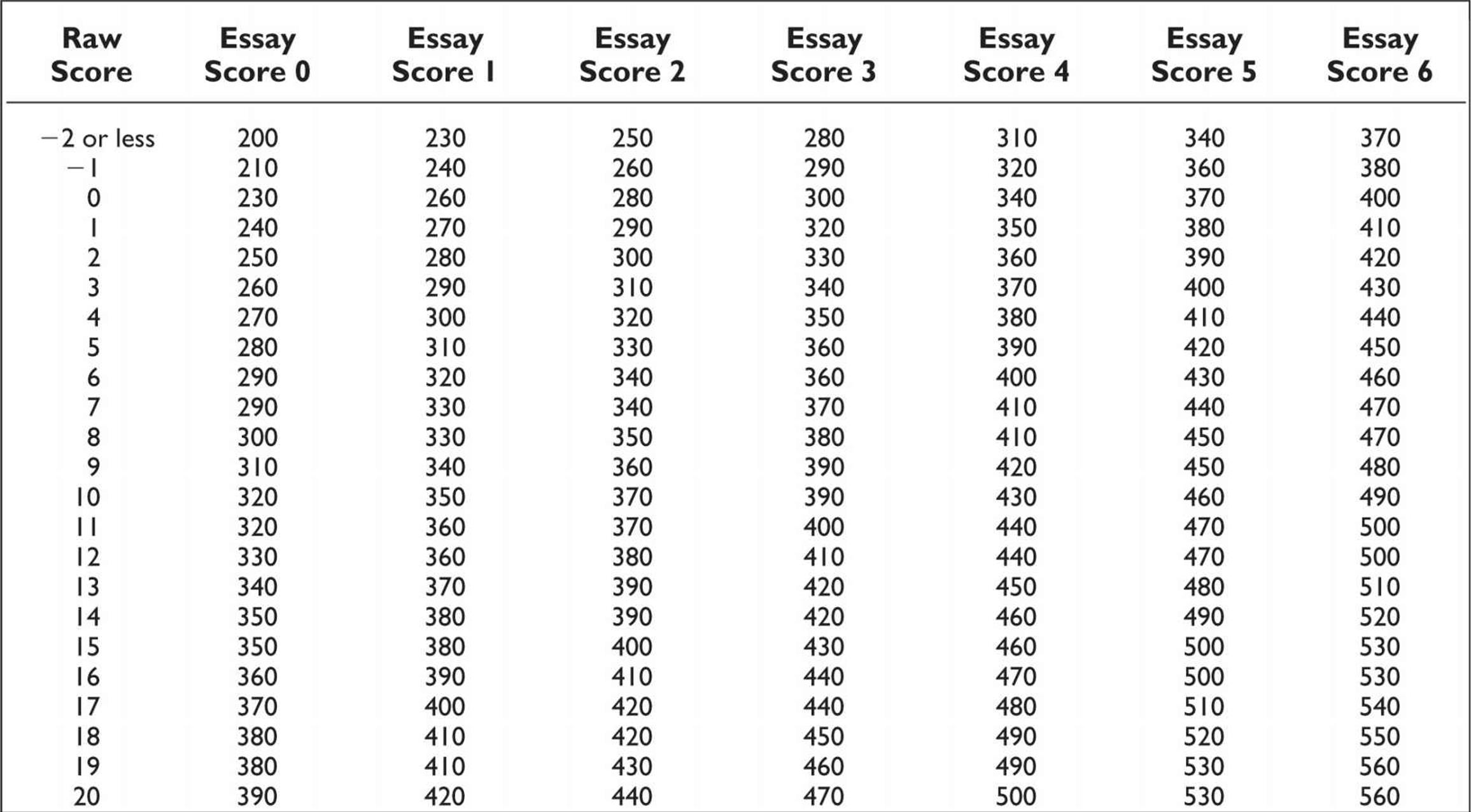
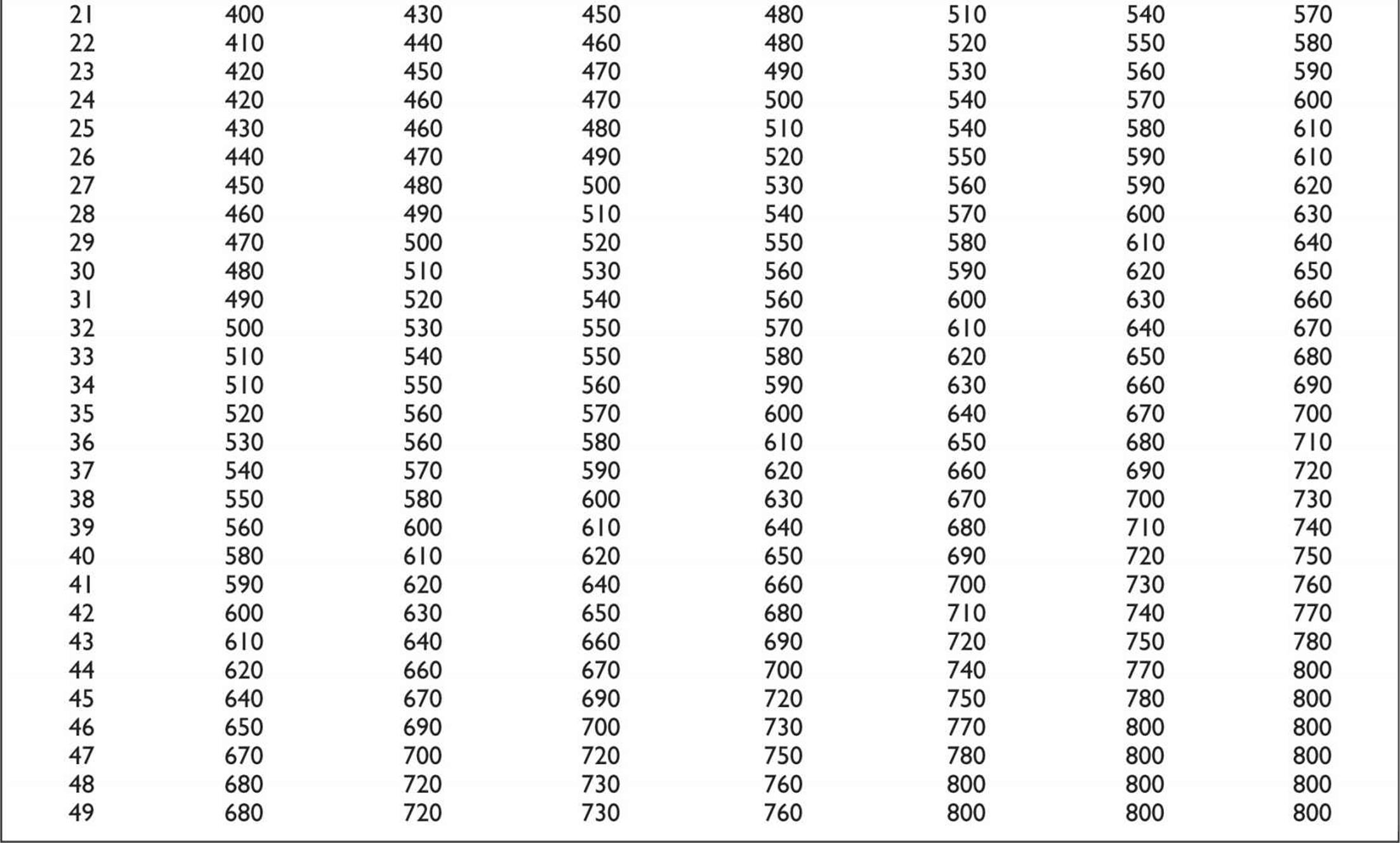
College Hill™ SAT Study Plan
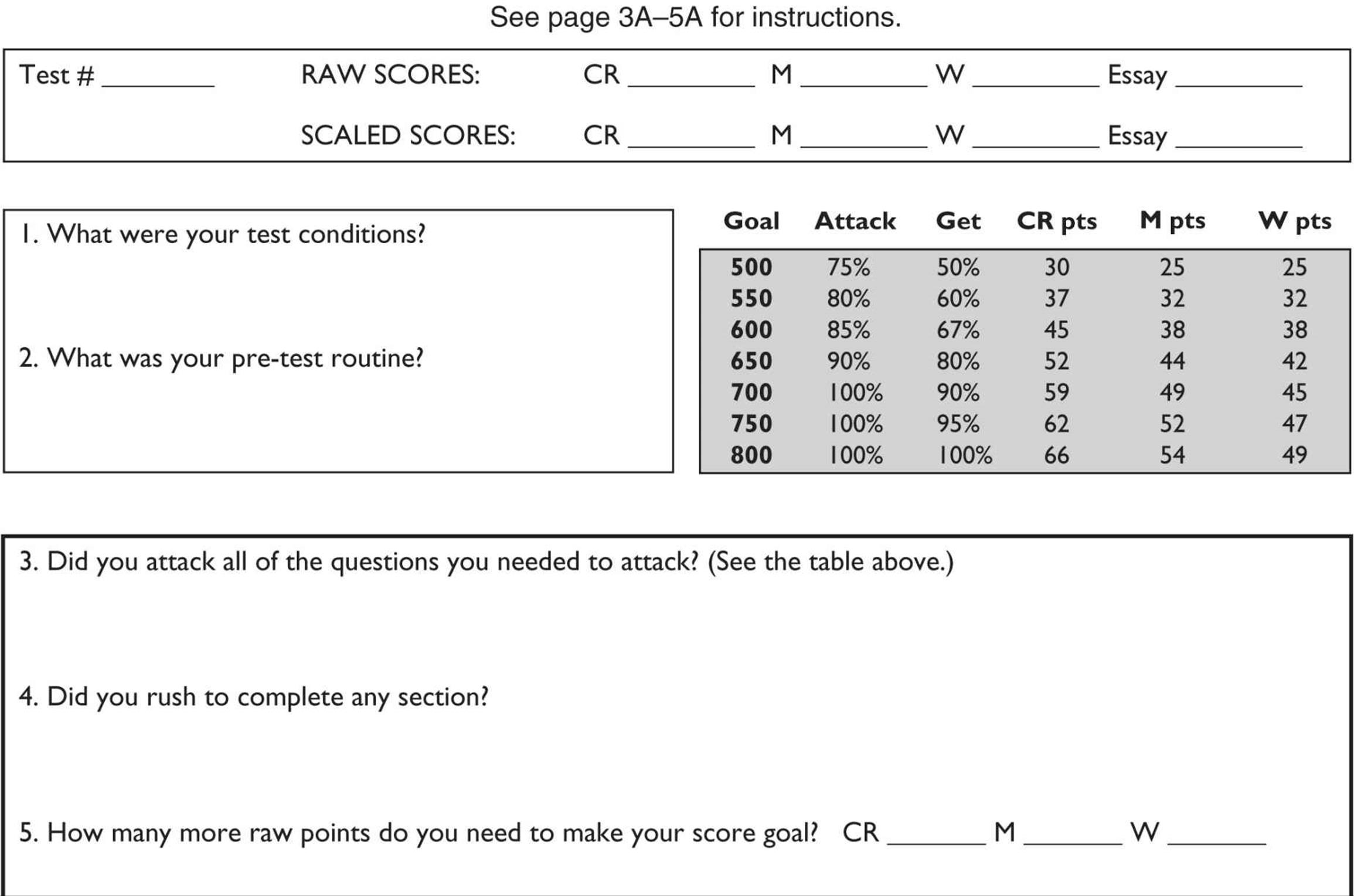
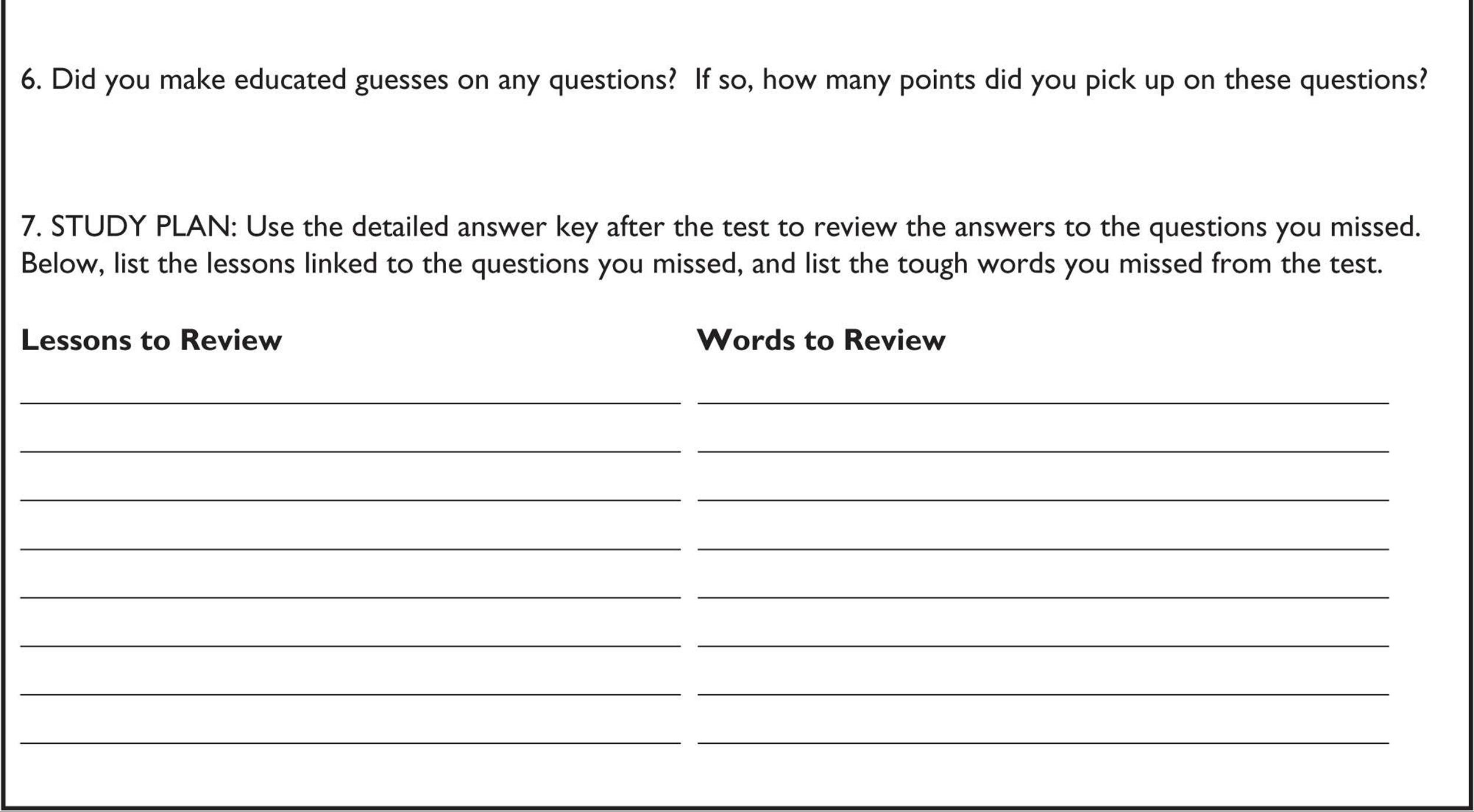
Detailed Answer Key
Section 1
Consider carefully the issue discussed in the following passage, then write an essay that answers the question posed in the assignment.
An entertainment-driven culture runs the risk of encouraging passivity among its citizens. If they can experience something vicariously through a movie, television show, or video game, why should they get involved with the activity itself? It”s safer, after all, to watch someone scale a mountain than to do it yourself. The effect of this passivity, of course, is an apathetic frame of mind. We cease to care deeply about so many things because they are experienced, at best, second-hand.
Assignment: Is apathy a problem in today”s society? Write an essay in which you answer this question and discuss your point of view on this issue. Support your position logically with examples from literature, the arts, history, politics, science and technology, current events, or your experience or observation.
The following essay received 6 points out of a possible 6, meaning that it demonstrates clear and consistent competence in that it
• develops an insightful point of view on the topic
• demonstrates exemplary critical thinking
• uses effective examples, reasons, and other evidence to support its thesis
• is consistently focused, coherent, and well organized
• demonstrates skillful and effective use of language and sentence structure
• is largely (but not necessarily completely) free of grammatical and usage errors
Every society seems to have platitudes about laziness, like “idle hands are the devil”s workshop.” This is because, to a society, the value of an individual is little more than his or her productivity. For many people, the worst kind of laziness is apathy, being too lazy to even care. But the fact is that we couldn”t survive if we cared about everything that was worth caring about. We would go insane. Furthermore, those who complain about apathy are usually the great manipulators of the world, trying to blame others for their own failures.
Holden Caulfield seemed to be apathetic to his teachers at Pencey Prep. But he was far from apathetic; indeed, he probably cared too much. His brother”s death and the suicide of a classmate affected him deeply, although he had trouble articulating his grief. He saw what the adults in his world seemed unable to see: the hypocrisy and meanness in the world. If he didn”t get away from the things that the teachers and other adults wanted him to care about, he probably would have gone crazy. Indeed, those adults thought he was crazy, but to Holden, it was the hypocritical world that was mad. His desperation to protect himself from the unbearable “phoniness” in the world led him, ironically, to often be phony himself. He hated his own hypocrisy, but he had to experience it to understand it. What others saw as apathy and cynicism was just his way of making it in the world.
Holden was quick to see that those who complained about his laziness and apathy were just the ones who wanted to control him because they couldn”t control their own lives. Teachers too often assume that, if their students aren”t “performing,” they must be lazy and apathetic. “You”re so smart. You would do well if you would just apply yourself.” Teachers see this kind of comment as supporting, but it is supremely degrading, and it covers up the teachers” inability to inspire or even understand their students.
Some people even go so far as to assume that entire societies are lazy or apathetic, simply because they do not share their same sensibilities or “productivity,” failing to see that productivity is often the product, not just of hard work, but of material and logistical advantage. I don”t have to work as hard, for instance, to be “productive” as a teenager in rural China, because I have free access to a computer, the internet, a local library, and helpful adult professionals. The Chinese teenager might be far more intelligent, diligent and resourceful than I, but far less “productive.”
Perhaps a sign of maturity and virtue in a society is the degree to which it values its citizens independently of their “productivity.” Every human being desires to build a better world in his or her own way. Sometimes that way does not involve making more money, getting better grades, or doing what society has established as “productive.”
The following essay received 4 points out of a possible 6, meaning that it demonstrates adequate competence in that it
• develops a point of view on the topic
• demonstrates some critical thinking, but perhaps not consistently
• uses some examples, reasons, and other evidence to support its thesis, but perhaps not adequately
• shows a general organization and focus but shows occasional lapses in this regard
• demonstrates adequate but occasionally inconsistent facility with language
• contains occasional errors in grammar, usage, and mechanics
The greatest danger to the modern world is not terrorists who have been indoctrinated into a twisted world view, but the masses of people who are indifferent to them, or even sympathize with them. “Live and let live,” so many people say. “They have a right to their point of view that women are animals and that someone who speaks against their religion should have his tongue cut out. That is just their way of thinking.” This apathy to the dangers of the world is even more dangerous than the terrorists themselves.
In Madrid, a band of Al Qaeda terrorists decided that it was a good idea, in March of 2004, to blow up 200 innocent commuters on a train so that they could influence the upcoming elections in Spain. They proclaimed that they love death more than westerners love life. They were hoping that the Spanish people would then be so frightened that they would elect a leader who would take Spain”s troops out of Iraq, as Al Qaeda wished. And that is exactly what happened.
The people of Spain didn”t care enough to realize that they were doing exactly what the terrorists were hoping they would do. The voters of Spain probably believed that they were making it less likely that the terrorists would strike again, but it was probably the exact opposite. The terrorists love to know that their violence scares people, and the Spanish people gave them what they wanted. Contrast this with the American response to terrorism: zero tolerance.
The worst evil occurs when good people do nothing. Millions of supposedly “good” German people sat on their hands as millions of “unwanted” Jews, gays and foreigners were slaughtered. Now, millions of people sit on their hands as religious fanatics look at the slaughter of innocent people as their ticket to paradise. It is unreasonable to believe that those with warped hatred of western cultures will stop their hatred and their evil deeds merely because they are appeased by weak governments.
The following essay received 2 points out of a possible 6, meaning that it demonstrates some incompetence in that it
• has a seriously limited point of view
• demonstrates weak critical thinking
• uses inappropriate or insufficient examples, reasons, and other evidence to support its thesis
• is poorly focused and organized and has serious problems with coherence
• demonstrates frequent problems with language and sentence structure
• contains errors in grammar and usage that seriously obscure the author”s meaning
When people don”t care about something, it”s hard to get anything done. If a team has players that don”t really want to play, for instance, it”s almost impossible to get them to win a game, even if you”re a master motivator. That”s why it”s so important to care about things and not have apathy.
If you don”t care about something, also, it”s just really difficult to be happy. You don”t have anything to look forward to in life. Some people don”t really care about school, and they just listen to their iPods and can”t wait to hang out with their friends or play their XBoxes when they get home. College doesn”t mean anything to them, and you can tell that they are miserable people. It”s one thing to question your teachers and wonder whether the things you learn in school are relevant for your life, but it”s entirely different to not even care about what you do in school even a little bit.
Research has shown that you can”t really get anywhere without an education, so if you don”t care about school you might as well not care about having any kind of successful life. If they would just find something important that they could care about, like a sport or a musical instrument or a job or something like that, then they might have something they could focus there life for, and have some positive purpose in life. Criminals probably come about because early on they didn”t really learn to care about anything important, and that is the real tragedy. and foreigners were slaughtered. Now, millions of people sit on their hands as religious fanatics look at the slaughter of innocent people as their ticket to paradise. It is unreasonable to believe that those with warped hatred of western cultures will stop their hatred and their evil deeds merely because they are appeased by weak governments.
Detailed Answer Key
Section 2

(Chapter 8, Lesson 1: Solving Equations)
2. B To buy 48 batteries in packages of 24, you will need two packages, which will ![]() . To buy them in packages of 6, you will need eight packages, which will cost
. To buy them in packages of 6, you will need eight packages, which will cost ![]() . Buying in packages of 24 will save
. Buying in packages of 24 will save ![]() .
.
(Chapter 9, Lesson 4: Rate Problems)
3. E You can probably solve this one best by quickly graphing each point and just inspecting. Clearly, (5, 5) lies outside the region. (Chapter 10, Lesson 4: Coordinate Geometry)
4. D Interpret the statement as an equation:

(Chapter 8, Lesson 7: Word Problems)
5. C The smallest positive integer that is divisible by 12 and 16 is 48. If n is 48, the only factor among the choices is (C) 48.
(Chapter 7, Lesson 7: Divisibility)
(Chapter 8, Lesson 5: Factoring)
6. D The sum of the angles in a triangle is 180°, so
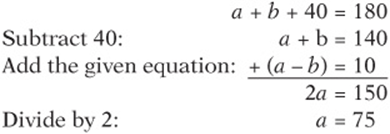
(Chapter 10, Lesson 2: Triangles)
(Chapter 8, Lesson 2: Systems)
7. E Choose ![]() as an example. Plugging this in to the choices gives answers of (A) ½ (B) 3 (C) 3 (D) 1 (E) 2. The only even number here is (E) 2.
as an example. Plugging this in to the choices gives answers of (A) ½ (B) 3 (C) 3 (D) 1 (E) 2. The only even number here is (E) 2.
(Chapter 9, Lesson 3: Numerical Reasoning Problems)
8. D Let c be the number of colas that Mike sold and r be the number of root beers. Since the total sold is 48, ![]() . Since he sold twice as many colas as root beers,
. Since he sold twice as many colas as root beers,![]() . Substituting this into the first equation gives
. Substituting this into the first equation gives

(Chapter 8, Lesson 7: Word Problems)
9. E Pick two perfect squares for m and n, like 4 and 9. Plugging these in to the examples gives (A) 36 (B) 36 (C) 16 (D) 324 (E) –45. The only choice that is not a perfect square is (E) –45.
(Chapter 8, Lesson 4: Working with Roots)
10. B One option is to solve each equation by plugging in 10 for a:
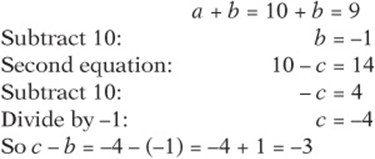
(Chapter 7, Lesson 6: Negatives)
11. E Since the average of four numbers is 8, the sum of those four numbers must be ![]() . Therefore
. Therefore ![]() Subtracting 14 from both sides gives
Subtracting 14 from both sides gives ![]() .
.
(Chapter 9, Lesson 2: Mean/Median/Mode Problems)
12. E Fill in the table above and to the left of the x by following the rule, like this:
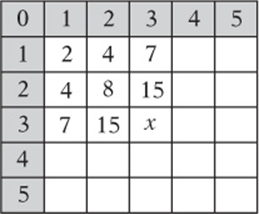
This shows that ![]() .
.
(Chapter 11, Lesson 5: Data Analysis)
13. D To maximize c you must minimize the value of a + b. Since the numbers must be positive and even, the least values that a and b can have are 2 and 4:

(Chapter 9, Lesson 3: Numerical Reasoning Problems)
14. B It is easier to pick a simple value for the “starting” population in 1980, like 100. Since the population increased by 10% from 1980 to 1990, the 1990 population must have been ![]() . Since it decreased by 10% from 1990 to 2000, the 2000 population must have been
. Since it decreased by 10% from 1990 to 2000, the 2000 population must have been ![]() . From 1980 to 2000, then, the percent change was
. From 1980 to 2000, then, the percent change was ![]() .
.
(Chapter 7, Lesson 5: Percents)
15. E According to the definition of g ![]() . According to the table,
. According to the table, ![]() , so
, so ![]() .
.
(Chapter 11, Lesson 2: Functions)
16. C Although you may substitute 5y for x as a first step, it”s probably easier to simplify the expression first:
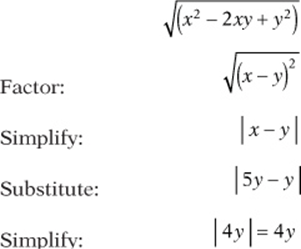
(Chapter 8, Lesson 4: Working with Roots)
(Chapter 8, Lesson 5: Factoring)
(Chapter 8, Lesson 6: Inequalities, Absolute Values, and Plugging In)
17. C Think of numbers that are larger than their squares. This excludes negatives, because the squares of negatives are always positive. It also excludes numbers greater than 1, because the squares of these are bigger than the original numbers. Therefore, ![]() . This means I and II are true, but not III.
. This means I and II are true, but not III.
(Chapter 9, Lesson 3: Numerical Reasoning Problems)
18. C Believe it or not, you don”t need to find the two midpoints in order to answer this question. You need to know only that the distance between the two mid-points is half of the distance between the two endpoints. The distance between the endpoints is ![]() . Half of this is
. Half of this is ![]() .
.
(Chapter 10, Lesson 4: Coordinate Geometry)
19. E Since all radii of a triangle are equal, ![]() . Since
. Since ![]() too, the triangle must be equilateral. Since its area is
too, the triangle must be equilateral. Since its area is ![]() the lengths have the measures shown in the diagram. The circle has a radius of 6. The shaded region is equal to the area of the sector minus the area of the triangle. Since the central angle is 60°, the sector has an area that is
the lengths have the measures shown in the diagram. The circle has a radius of 6. The shaded region is equal to the area of the sector minus the area of the triangle. Since the central angle is 60°, the sector has an area that is ![]() of the whole circle, or
of the whole circle, or ![]() Subtracting the area of the triangle gives .
Subtracting the area of the triangle gives .![]() .
.
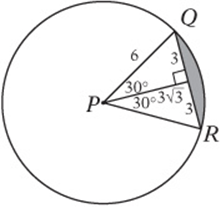
(Chapter 10, Lesson 3: The Pythagorean Theorem)
(Chapter 10, Lesson 5: Areas and Perimeters)
(Chapter 10, Lesson 8: Circles)
20. C If the ratio of boys to girls in a class is 3 to 5, then ![]() of the class is boys and
of the class is boys and ![]() of the class is girls. This means there are
of the class is girls. This means there are ![]() boys and
boys and ![]() girls in the senior class. Similarly, the fraction of boys in the junior class is
girls in the senior class. Similarly, the fraction of boys in the junior class is ![]() and the fraction of girls is
and the fraction of girls is ![]() . If there are x students in the junior class, then there are (
. If there are x students in the junior class, then there are (![]() ) x boys and (
) x boys and (![]() ) x girls in the junior class. If the ratio of boys to girls is 1:1 when the classes are combined, then
) x girls in the junior class. If the ratio of boys to girls is 1:1 when the classes are combined, then

(Chapter 8, Lesson 7: Word Problems)
(Chapter 7, Lesson 4: Ratios and Proportions)
Section 3
1. A A six-month hiatus (break) would cause her skills to weaken, something she might fear. atrophy = weaken from disuse; align = line up; disseminate = spread like seed
2. C Domineering opinions are overbearing and preachy. vindictive = inspired by revenge; pedantic = acting like a know-it-all; conciliatory = acting to bring people together; treacherous = betraying someone”s confidence; didactic = preachy; dogmatic = condescendingly preachy; prosaic = ordinary
3. A The missing word must refer to Walter”s inability to make up his mind. vacillation = inability to make up one”s mind; solicitation = request for help; rejuvenation = restoration of one”s youth; admonishment = mild reproof
4. D If a writer is successful … even in the face of … rejections, he or she must be very persistent. affluence = wealth; haughty = arrogant; pertinacity = strong persistence; resilient = able to endure hardship; tenacity = ability to hold fast; relentless = unwilling to give up; stoutness = courage or sturdiness; craven = cowardly
5. B The missing word must be in contrast to direct, forceful stances. pontification = haughty, self-important speech; circumlocution = indirect, evasive speech; brevity = conciseness
6. E The parallelism of the two clauses helps you to complete the sentence. If counselors believe that criminals can change, then they must have faith in their changeability. If they realize that they can often return to their old habits, they must by wary of recidivism (tendency to fall into old habits). mutability = changeability; astuteness = keen ability; transcendence = the quality of exceeding; malleability = ability to be bent; relapse = falling back into old ways
7. B If something is out of place in time, it is an anachronism. anachronism = something out of place in time; idiom = phrase with a meaning that is different from its literal meaning; interlocutor = someone who takes part in a conversation
8. C The sentence indicates that the “h” was evidence of an earlier time. inference = conclusion based on evidence; analogy = useful comparison; vestige = remaining trace; anomaly = unusual event; quandary = perplexing situation
9. A The passage states that language is used as impenetrable walls (line 7) between people, having biased connotations favoring one group over another.
10. D By saying that we infer volumes (lines 3–4), the author means that we draw a lot of conclusions.
11. E The passage states that instructing a child to tie shoes the right way will defeat the child”s growing attempt at self-mastery (lines 12–14).
12. B The last sentence states that nagging is a constant reminder to the child of his or her lack of self-control (lines 21–22).
13. C The author states that Modernism is egotistical (line 19) and self-conscious (line 21) and also that it begins nowhere and with no one in particular (lines 12–13), suggesting that it is both self-centered and ill-defined, but the paragraph does not mention Modernism being politically oriented.
14. A The passage states that Critics and academics … prefer their artistic movements to be readily comprehensible (lines 8–10), so they do not like those that are hard to understand.
15. D The quotation from James Joyce in the next sentence describes these landmines as enigmas and puzzles that … will keep the professors busy for centuries arguing over what I meant (lines 21–25). In other words, they are literary devices placed in his novels to baffle professors.
16. B The passage states that plots … are submerged beneath wave after wave of … hyper-literary and metaliterary indulgences (lines 32–37), so it suggests that plot is not as important as other things.
17. A The author states that it is hard not to love modernism (lines 38–39) but also uses critical terms like posturing aberrations (line 19) to describe it. In the last two lines, he refers to modernism as reprehensive but somehow roguishly likeable. This is a very ambivalent characterization of modernism.
18. A The comparison is a metaphor but not a simile because it states that the modernist novel is a sociopath. Juxtaposition is the placement of two images one on top of the another, as in a sociopath and a cad. Personification is giving human qualities to something that is not human.
19. D The purpose of the passage is to introduce the reader to the new science of genomics.
20. C A pathogen (line 8) is not part of the immune system (lines 7–8) but rather what the immune system responds to.
21. B The orchestrated response of the immune system (lines 7–8) is mentioned as an example of how molecules convey information (line 9).
22. E The fact that through genomics massive amounts of information can be converted into an electronic format (lines 36–38) is what facilitates a dramatically new framework for understanding life (lines 40–41).
23. C The passage suggests that information theory … may seem unfit for … science (lines 50–52) because information … implies an underlying intent (lines 48–50).
24. D The final paragraph indicates that genomic advances have helped to propel the remarkable development of the computer and telecommunication industries (lines 58–60) and suggests that they may help to improve human health (lines 61–62). This discusses actual and potential consequences.
Section 4
1. A The sentence is correct.
2. E The underlined phrase should be a noun phrase that represents one of the best features of the journalist”s lifestyle. Only (C) and (E) are noun phrases, and (E) is much clearer.
(Chapter 15, Lesson 4: Comparison Problems)
3. B The opening participial phrase modifies Greg and not Greg”s search.
(Chapter 15, Lesson 7: Dangling and Misplaced Participles)
4. C Idiom requires neither to be followed by nor, and parallelism requires the nor to be followed by an adjective.
(Chapter 15, Lesson 10: Idiom Errors)
5. D The past participle of to take is taken, not took.
(Chapter 15, Lesson 13: Irregular Verbs)
6. C Although choice (D) is parallel in structure, its phrasing is nonstandard. The phrasing in (C) is both parallel and clear.
(Chapter 15, Lesson 3: Parallelism)
7. A The pronoun he is the subject of an implied verb, he (did), so it is used correctly in the subjective form. Also, the phrase admire his acting is correct, because the object of the verb is acting, not him.
(Chapter 15, Lesson 6: Pronoun Case)
8. B Neither is the singular subject of the verb, so the verb should be was, not were. Also, the pronoun should be its because the subject is singular and a ram can only feel its own pain, not the pain of them both.
(Chapter 15, Lesson 1: Subject-Verb Disagreement)
(Chapter 15, Lesson 2: Trimming Sentences)
(Chapter 15, Lesson 5: Pronoun-Antecedent Disagreement)
9. B The participle walking modifies Liz, not Liz”s family. Choice (D) makes this correction, but the modifiers are awkward and unclear.
(Chapter 15, Lesson 7: Dangling and Misplaced Participles)
(Chapter 15, Lesson 12: Other Modifier Problems)
10. E The phrase if not better is an interrupter, so the sentence should read well even if it is omitted. The only phrasing that meets this criterion is (E).
(Chapter 15, Lesson 2: Trimming Sentences)
11. E The original is not a sentence but a fragment.
(Chapter 15, Lesson 15: Coordinating Ideas)
12. D The phrase much closer modifies the verb study and so should be in adverbial form: much more closely.
(Chapter 15, Lesson 12: Other Modifier Problems)
13. B The two clauses must be parallel: has been so popular would make this clause parallel to the first.
(Chapter 15, Lesson 3: Parallelism)
14. D This is a diction error. Respectfully means full of respect, which makes no sense here. The word should be respectively.
(Chapter 15, Lesson 11: Diction Errors)
15. D The verb would have considered is in the wrong tense and mood. It should be consider.
(Chapter 15, Lesson 9: Tricky Tenses)
(Chapter 15, Lesson 14: The Subjunctive Mood)
16. E The sentence is correct.
17. C The fund deficit and the disillusionment are not a single problem, but two problems.
(Chapter 15, Lesson 4: Comparison Problems)
18. B The subject of the verb is either accepting or rejecting. If the subject of a verb is an either … or construction, the verb must agree with the noun after the or, which in this case is rejecting. Since this is a singular noun, the verb should be was.
(Chapter 15, Lesson 1: Subject-Verb Disagreement)
19. C Since defense attorneys can be counted, the correct comparative word is fewer, not less.
(Chapter 15, Lesson 4: Comparison Problems)
20. B It is illogical to compare service to other restaurants. The phrase should be the service at the other restaurants.
(Chapter 15, Lesson 3: Parallelism)
21. E The sentence is correct.
22. C This pronoun refers to a child, so it must be the singular he or she.
(Chapter 15, Lesson 5: Pronoun-Antecedent Disagreement)
23. C The phrase not only A but also B indicates a parallel structure. To make the structure parallel, the phrase should be replaced with by.
(Chapter 15, Lesson 3: Parallelism)
24. E The sentence is correct.
25. B The pronoun he is ambiguous. We are not certain which individual it is referring to. To correct the error, he should be changed to either Thomas Cowher or the Senator.
(Chapter 15, Lesson 5: Pronoun-Antecedent Disagreement)
26. C The sentence indicates that this occurred in the past by saying those who were observing. Therefore are should instead be were.
(Chapter 15, Lesson 1: Subject-Verb Disagreement)
27. E The sentence is correct.
28. A Between my brother and I should instead be between my brother and me. Subjective pronouns, such as I, should only be used as subjects. Objective pronouns, including me, can be used as objects of verbs or as objects of prepositions.
(Chapter 15, Lesson 6: Pronoun Case)
29. C The critic is writing about a duo, which is a singular subject. The their should therefore be replaced by its.
(Chapter 15, Lesson 5: Pronoun-Antecedent Disagreement)
30. A Choice (A) is the most concise and clear, and the phrasing is parallel.
(Chapter 15, Lesson 3: Parallelism)
(Chapter 15, Lesson 15: Coordinating Ideas)
31. B Sentence 3 presents an example of Plato”s reasoning as described in sentence 2. Choice (C) may be tempting, but since the sentence does not extend the idea from sentence 2 but only provides an example, the word furthermore is inappropriate.
(Chapter 15, Lesson 15: Coordinating Ideas)
32. B The pronoun they and the noun approximations should agree in number. Choice (B) provides the most straightforward phrasing.
(Chapter 15, Lesson 5: Pronoun-Antecedent Disagreement)
(Chapter 15, Lesson 15: Coordinating Ideas)
33. D Sentence 6 does not fit because it shifts the discussion to what students dislike, rather than the nature of mathematical objects.
34. E Choice (E) provides the most logical, concise, and clear phrasing.
35. A Choice (A) provides the most logical, concise, and clear phrasing.
Section 5
1. E If ![]() , then
, then ![]() , and if
, and if ![]() , then
, then ![]() , so
, so ![]() .
.
(Chapter 6, Lesson 4: Simplifying Problems)

(Chapter 9, Lesson 2: Mean/Median/Mode Problems)
3. C If ![]() , then
, then ![]() , because the two angles form a linear pair. So
, because the two angles form a linear pair. So ![]() and
and ![]() . Your diagram should now look like this:
. Your diagram should now look like this:
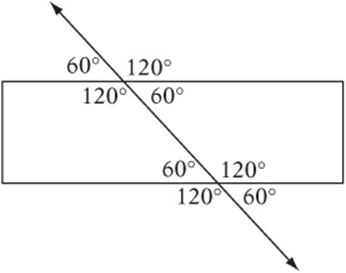
So ![]() .
.
(Chapter 10, Lesson 1: Lines and Angles)
4. A Substitute ![]() into the function:
into the function:
![]()
(Chapter 11, Lesson 2: Functions)
5. B If ![]() , then
, then ![]() . So
. So ![]() . Checking the powers of 3 shows that
. Checking the powers of 3 shows that ![]() . Therefore,
. Therefore, ![]() , so
, so ![]() .
.
(Chapter 8, Lesson 3: Working with Exponentials)
6. C If b varies inversely as the square of c, then the equation that relates them is ![]() where k is some constant. To find the value of k, just plug in the given values for b and c:
where k is some constant. To find the value of k, just plug in the given values for b and c:

Therefore, the specific equation relating b and c is ![]() . To find the value of c when
. To find the value of c when ![]() , just substitute and solve:
, just substitute and solve:

(Chapter 11, Lesson 4: Variation)
7. C Each of the five teams must play four other teams three times apiece. In other words, each team must play in ![]() games. Since there are five teams, it might seem at first that there are a total of
games. Since there are five teams, it might seem at first that there are a total of ![]() games, but since each game needs two teams, the total number of games is
games, but since each game needs two teams, the total number of games is ![]() .
.
(Chapter 9, Lesson 5: Counting Problems)
8. A If pump A can fill the tank in 3 hours, then it will fill ![]() of the tank in 1 hour, leaving
of the tank in 1 hour, leaving ![]() of the tank to fill. Pump B can fill ½ of the tank in an hour, so working together, the two pumps can fill
of the tank to fill. Pump B can fill ½ of the tank in an hour, so working together, the two pumps can fill ![]() of the tank per hour. To fill
of the tank per hour. To fill ![]() of the tank working together, then, takes
of the tank working together, then, takes ![]() hour, which equals
hour, which equals ![]() minutes.
minutes.
(Chapter 9, Lesson 4: Rate Problems)

(Chapter 8, Lesson 7: Word Problems)

(Chapter 9, Lesson 1: New Symbol or Term Problems)
11. 100 Circumference = πd, so you can find the diameter:

This diameter is also the hypotenuse of a right triangle, so by the Pythagorean theorem, ![]() .
.
(Chapter 10, Lesson 3: The Pythagorean Theorem)
(Chapter 10, Lesson 8: Circles)
12. 24 This is a “counting” problem, so it helps to know the fundamental counting principle from Chapter 9, Lesson 5. Since you are making a three-letter arrangement, there are three decisions to be made. The number of choices for the first letter is four; then there are three letters left for the second spot, then two left for the third spot. This gives a total of ![]() possible arrangements.
possible arrangements.
(Chapter 9, Lesson 5: Counting Problems)
13. 0.2 or 1/5 This is a simple substitution. You can substitute 10,200 for 96,878 ×x2 because they are equal. So ![]() . Notice that the 10,200s “cancel.”
. Notice that the 10,200s “cancel.”
(Chapter 6, Lesson 4: Simplifying Problems)
14. 4 If each term is 1 less than 3 times the previous term, then each term is also ![]() of the number that is 1 greater than the successive term. Since the fourth term is 95, the third term must be
of the number that is 1 greater than the successive term. Since the fourth term is 95, the third term must be ![]() of 96, which is 32. Repeating this shows that the second term is 11 and the first term is 4. Check your work by confirming that the sequence satisfies the formula.
of 96, which is 32. Repeating this shows that the second term is 11 and the first term is 4. Check your work by confirming that the sequence satisfies the formula.
(Chapter 6, Lesson 7: Thinking Logically)
(Chapter 11, Lesson 1: Sequences)
15. 0.8 If ![]() then
then ![]() .
.
So ![]() .
.
(Notice that you don”t really have to deal with the root!)
(Chapter 8, Lesson 1: Solving Equations)
16. 5 If there are a adults, there must be 30 – a children, because the total number of people is 30.
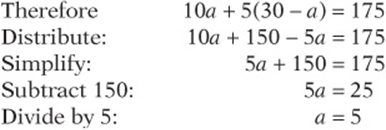
Now check: if there are 5 adults, there must be 25 children, and the tickets would cost ![]() (yes!).
(yes!).
(Chapter 8, Lesson 7: Word Problems)
17. 9 Since ![]() , the perimeter of the triangle is
, the perimeter of the triangle is ![]() . The perimeter is 24, so
. The perimeter is 24, so
![]()
(Chapter 10, Lesson 5: Areas and Perimeters) (Chapter 7, Lesson 4: Ratios and Proportions)
18. 10
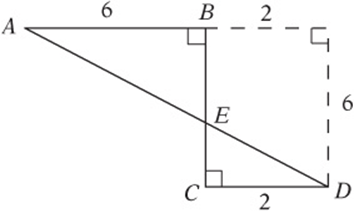
Mark the diagram with the given information. The dotted lines show that AD is the hypotenuse of a right triangle with legs of length 8 and 6. So to find it, just

(Chapter 10, Lesson 3: The Pythagorean Theorem)
(Chapter 10, Lesson 5: Areas and Perimeters)
Section 6
1. A Because the signal was strange, it was clearly not an expected result, but it was also not from outside of the telescope, so it was a strange happening from the telescope itself. malfunction = disruption of the normal workings; bulwark = defensive fortification; anthology = collection of literary works; mutation = change in form
2. B The problem is one that may never be solved, so it is difficult or stubborn. impotent = weak and ineffective; intractable = hard to manage, stubborn; evanescent = likely to vanish; irate = angry; insipid = dull, tasteless
3. E If the general was surprised at the ease with which the defenses were breached, he must have expected the resistance to be much stronger. ephemeral = short-lived; compatible = working well together; egregious = blatant or extreme; imposing = intimidating
4. B A dependence on electronic devices would be expected to tax the power grid, although increased efficiency of those devices would be expected to ease the burden. abated = decreased in intensity; attenuated = caused to be less intense; compromised = rendered vulnerable; flourished = thrived
5. E The word although indicates a contrast. Although the persecution vanquished (conquered) the will of some, it must have strengthened the will of others. despotic = tyrannical; squandered = wasted; amenable = obedient; celebrated = eminent; ruthless = merciless; forged = established
6. C The passage says that Rousseau”s writings (line 1) were what led Goethe to say that “feeling is all” (line 4). Therefore, Goethe was influenced by Rousseau.
7. D The passage says that Kant forgot to take his … daily walk because he was so absorbed in reading Rousseau”s Émile (lines 14–16).
8. C Passage 1 states that “by emphasizing feeling” (line 3) Rousseau inspired the Romantic movement and Goethe in particular, while Passage 2 criticizes Rousseau”s “worship of emotion” (line 33) as encouraging poor parenting.
9. B Passage 1 states that Rousseau “inspired the French Revolution” (lines 9–10) and Passage 2 gives Rousseau credit for laying the “philosophical foundation of American independence” (lines 31–32).
10. E By saying “It would be a good idea,” Gandhi indicated that civilization in the West had not really been realized.
11. B The voices are those who are bankrolled by large corporations (lines 16–17) and who are saying such things (line 15) as that America is a model of free-market capitalism (line 11). This would certainly not include Mahatma Gandhi, but the passage indicates that it would includepoliticians and those in corporate news and entertainment media (lines 8–10).
12. C The second paragraph explains how the concept of free trade (line 20) works, so it is explaining a concept.
13. A The statement suggests that the rules of free trade would work differently if the parties involved were different, suggesting that the rules are selectively applied.
14. A This paragraph indicates that these words are being used ironically. It states that the Indians (gave in to Western pressure) (lines 55–56), so the agreement was not a completely free one. Also, the words “liberalize” and “liberalization” are used ironically because they refer to actions that in fact reduced competition and were (a great blow to free markets) (lines 64–65).
15. D The triumph was also described as a great blow to free markets (lines 63–65).
16. B The paragraph indicates that businesses are … expected to wager their own capital on success in the marketplace (lines 66–68) but that some pharmaceutical companies don”t need to.
17. C In lines 14–15, the narrator describes the instruction as being “clear and facile to my apprehension,” which means he found it easy to understand.
18. D The phrase clear and facile to my apprehension means easy to understand.
19. B The narrator says that a mind of moderate capacity which closely pursues one study must infallibly arrive at great proficiency (lines 22–24), thereby suggesting that only diligence is required for proficiency.
20. A The narrator was as well acquainted with the theory and practice of natural philosophy as depended on the lessons of any of the professors at Ingolstadt (lines 32–35), which means he had learned all he could from them.
21. C This supernatural enthusiasm describes the narrator”s passion for his studies.
22. B The human bodies are described as changing from the seat of beauty and strength in life to food for the worm (line 68) in death.
23. C The rest of the sentence describes how the processes of death change a formerly living body. In saying that he beheld the corruption of death succeed to the blooming cheek of life, he is saying that death and decay have replaced or defeated life.
24. E The narrator reveals his sense of privilege in this discovery by stating that he is alone (line 83) among the many men of genius (line 81) who had studied this topic before.
Section 7
1. C 16 is equal to 2(7) + 2, so it is two more than a multiple of 7.
(Chapter 7, Lesson 7: Divisibility)
2. E Five oranges can be bought for 5¢ more than the price of four, which is ![]() . $3.40 is equivalent to 4(.85), so it will buy
. $3.40 is equivalent to 4(.85), so it will buy ![]() oranges.
oranges.
(Chapter 8, Lesson 7: Word Problems)
3. A If r is positive, then –r is negative. If you add another negative, then the result will be even more negative.
(Chapter 7, Lesson 6: Negatives)
4. D Twelve less than the product of 3 and x + 1 can be represented as

(Chapter 8, Lesson 7: Word Problems)
5. C The square has an area of ![]() square feet.
square feet. ![]() , so this will require eight bags of seed at $25 apiece.
, so this will require eight bags of seed at $25 apiece. ![]() .
.
(Chapter 10, Lesson 5: Areas and Perimeters)
6. C Analyzing the right angle shows that ![]() . Since the sum of the angles in a triangle is always 180°,
. Since the sum of the angles in a triangle is always 180°,

(Chapter 10, Lesson 2: Triangles)
7. D If the numbers have a product of 0, then at least one must equal 0. Call the numbers x, y, and 0. The problem also says that ![]() and
and ![]() .
.
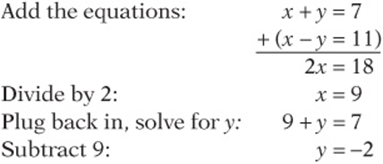
So the least of the numbers is –2.
(Chapter 8, Lesson 2: Systems)
8. A You can draw a diagram and see that there are only four possible triangles:
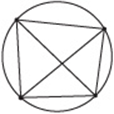
If you prefer to look at it as a “combination” problem, the number of triangles is the number of ways of choosing three things from a set of four, or ![]() .
.
9. B The only way that abc would not be a multiple of 4 is if none of the three numbers is a multiple of 4 and no two of them are even (because the product of two evens is always a multiple of 4). One simple example is ![]() ,
, ![]() , and
, and ![]() . This example rules out choices (A), (C), (D), and (E).
. This example rules out choices (A), (C), (D), and (E).
(Chapter 9, Lesson 3: Numerical Reasoning Problems)
10. A A large percent change from 2002 to 2003 is represented by a point in which the y-coordinate is much greater than the x-coordinate. Point A represents a change from 30 in 2002 to 70 in 2003, which is a percent change of ![]() .
.
(Chapter 7, Lesson 5: Percents)
(Chapter 11, Lesson 5: Data Analysis)
11. E If both classes have 100 students, then class B had 30 students participate in 2002 and 50 in 2003, for a total of 80. Class E had 80 in 2002 and 60 in 2003, for a total of 140. The difference, then, is ![]() .
.
(Chapter 11, Lesson 5: Data Analysis)
12. E If class D has 120 students, then 80% of 120, or 96 students participated in 2002. If the same number participated from class C, then 96 is 60% of the number of students in class C. If the number of students in class C is x, then ![]() . Divide by
. Divide by ![]() .
.
(Chapter 11, Lesson 5: Data Analysis)
13. E Substitute ![]() into the equation to find c.
into the equation to find c.

Factor the quadratic (remember that since ![]() is a solution, (x + 1) must be a factor):
is a solution, (x + 1) must be a factor): ![]()
![]()
So the solutions are ![]() and
and ![]()
(Chapter 8, Lesson 5: Factoring)
14. C To create a three-digit number, three decisions must be made: you must choose the first digit, then choose where to put the two, then choose the final digit. Since the first digit must be odd, there are three options for the first digit. Since the two may be placed in either the second or the third slot, there are two options. Then there are three digits left to choose for the final slot. This means there are ![]() possibilities.
possibilities.
(Chapter 9, Lesson 5: Counting Problems)
15. C Since one pound feeds five chickens, four pounds are needed to feed 20 chickens. This leaves ![]() pounds of feed. Since each pound can feed two pigs, six pounds can feed
pounds of feed. Since each pound can feed two pigs, six pounds can feed ![]() pigs.
pigs.
(Chapter 6, Lesson 2: Analyzing Problems)
(Chapter 7, Lesson 4: Ratios and Proportions)
16. A Since 120° is 1/3 of 360°, the shaded region has ![]() the area of the circle. Therefore, the circle has an area of
the area of the circle. Therefore, the circle has an area of ![]() . Since
. Since ![]() , the radius is 3 centimeters. The circumference of the circle, then, is
, the radius is 3 centimeters. The circumference of the circle, then, is ![]() , and the arc of the shaded region has length
, and the arc of the shaded region has length ![]() . The perimeter of the shaded region, then, is
. The perimeter of the shaded region, then, is ![]() .
.
(Chapter 10, Lesson 5: Areas and Perimeters)
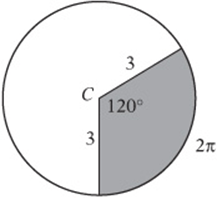
Section 8
1. D The word rather indicates the important contrast between the two ideas. The second word indicates something specific to a single director rather than many visions. conglomeration = collection; insubordination = disobedience; prudence = careful management; bastion = a well-fortified area; synthesis = a fusion of different elements; conspiracy = secret agreement to commit a crime
2. B The fact that modern readers read a book once and then discard it suggests that their interest in it is only temporary, rather than timeless. immoral = unethical; fleeting = short-lived
3. A Although indicates a contrast in ideas, so the missing word must mean prolonged rather than short-term. protracted = prolonged; contemporaneous = living or existing at the same time; transient = short-lived; surreptitious = secretive; fickle = tending to change one”s mind often
4. C Since the sentence says that athletes are treated like successful warriors, you should look for a word like celebrated. invoked = called on or cited; repudiated = having its validity rejected; lionized = treated like a celebrity; vilified = defamed; beguiled = deceived by charm
5. E The word although indicates a contrast. Although the persecution vanquished (conquered) the will of some, it must have strengthened the will of others. despotic = tyrannical; squandered = wasted; amenable = obedient; celebrated = eminent; ruthless = merciless; forged = established
6. B If she was an opponent of the male hegemony (dominance of one group over another), she must have been an outspoken critic of the male-dominated society. matriarchal = female-dominated; pugnacious = belligerent; patriarchal = male-dominated; vociferous = outspoken; avuncular= like a good-natured uncle; belligerent = inclined to picking fights; rudimentary = basic; liberal = free-thinking
7. C The author begins by making the point that the spelling profession (line 1) kills genius. By saying that Shakespeare was not a good speller but was more of a genius than Noah Webster, he is reinforcing the point, thereby suggesting that Webster is someone in the “spelling profession.”
8. E The previous two sentences discuss the fact that any attempt to make spelling easier would undermine the author”s excuse for bad spelling (line 18).
9. E Serena”s plan is to have people avoid spelling words with silent letters, but not change the way they pronounce words. This would require a change in writing habits.
10. C Serena”s plan is to boycott (line 77) words with superfluous letters. Boycotting is a form of protest. By saying that her plan is more American than his, the author suggests that Americans are inclined to protest things.
11. A The author says he wants to set the idle letters to work (lines 50–51) by pronouncing them, while Serena plans to ignore all words that contain superfluous letters (lines 75–76).
12. A In the final paragraph of Passage 1, the author says that he replaced the Platonic friendship he had with Serena with ardent love (lines 85–86) because he didn”t know how to spell the word friend.
13. D The chaos is mentioned as the result of failing to impose standards for spelling particular words and instead spelling a word in many different ways according to how it is pronounced in different dialects.
14. B Passage 2 says that standardized spelling obscures those spoken dialects that are so often used to stratify and separate us (lines 116–118).
15. A Passage 2 says that the silent letters in the word “eight” are a treasure trove (lines 126–127) to those who study the history of language.
16. A Passage 1 is clearly intended to be humorous, while Passage 2 is very systematic in discussing the problems with the spelling reform movement.
17. D Passage 1 says that Americans do not like sudden changes (line 29) to suggest the difficulty in enacting spelling reform. Similarly, Passage 2 says that languages are not influenced very much by plan or reason (lines 131–132).
18. D Because the final paragraph of Passage 2 discusses the problem of enacting a plan to change the conventions of language, the author of Passage 2 would likely regard such a plan as unworkable.
19. C The first passage discusses although as a word with too many silent letters, while Passage 2 discusses it because it contains a letter sequence that can be pronounced in many different ways.
Section 9
1. C The original sentence is a run-on sentence. Answer choice (C) properly coordinates the two ideas.
(Chapter 15, Lesson 15: Coordinating Ideas)
2. B In the original sentence, a better debater should instead be better debaters, the plural form. Answer choice (B) corrects this error.
(Chapter 15, Lesson 5: Pronoun-Antecedent Disagreement)
3. B Billy the Bobcat is a singular subject and the verb have is plural. It should instead be has.
(Chapter 15, Lesson 1: Subject-Verb Disagreement)
4. B The pronoun when should be used only to refer to a time. It should be replaced by who.
(Chapter 15, Lesson 5: Pronoun-Antecedent Disagreement)
5. A This sentence is correct as written.
6. E The original sentence is phrased awkwardly. As constructed it suggests that the U.S. enjoyed peace and economic well being more than any time did, which makes no sense. Answer choice (E) corrects this comparison error.
(Chapter 15, Lesson 4: Comparison Problems)
7. D The phrase because of is awkward. Answer choice (D) corrects the error in the most concise and logical fashion.
(Chapter 15, Lesson 10: Idiom Errors)
8. D The sentence requires parallel structure. Jerry Lewis hosted a variety show and an annual telethon. Answer choice (D) corrects the error.
(Chapter 15, Lesson 3: Parallelism)
9. B You should not begin the clause after a semicolon with and because it is supposed to be an independent clause. Answer choice (B) properly coordinates the two ideas.
(Chapter 15, Lesson 15: Coordinating Ideas)
10. B As originally constructed, the sentence suggests that the children themselves contain violent imagery, rather than the video games contain violent imagery. Answer choice (B) corrects this error.
(Chapter 15, Lesson 15: Coordinating Ideas)
11. B The opening participial phrase, walking hand-in-hand improperly modifies the vendor rather than the couple. Answer choice (B) corrects this error.
(Chapter 15, Lesson 7: Dangling and Misplaced Participles)
12. C The original sentence is awkward and wordy. The phrasing in answer choice (C) is the most concise and logical of the choices.
(Chapter 15, Lesson 2: Trimming Sentences)
13. D This question presents an illogical comparison. As written, the parents today spend more time working than 30 years ago did. The sentence is trying to say that parents today spend more time working than parents did 30 years ago. Answer choice (D) corrects the error.
(Chapter 15, Lesson 4: Comparison Problems)
14. B The phrase if they would have in (E) is incorrect subjunctive form, and the comparison between the language and the Borneans is illogical.
(Chapter 15, Lesson 14: The Subjunctive Mood)
(Chapter 15, Lesson 4: Comparison Problems)